




After spending far too much time on apps and social media over the last few years, Gemma decided it was time for a change.
“I’d started to get really frustrated with how I was spending my spare time”, said Gemma, 54 from London. “One day, I realised I’d checked my phone over 100 times. Something had to give.”
“So, I deleted my social media apps from my phone and made a promise to myself to do something more positive with my time.”
At first, it wasn’t easy for Gemma to find things to do.
“I’m embarrassed to admit that I’d stopped reading as much over the last couple of years. But, then a friend recommended Readly to me. I’d always loved reading magazines and thought it was time to give them a go again.
The selection is amazing: food, fitness, lifestyle, culture, crafts and

hobbies are all covered. I’ve been using Readly in the evenings to relax instead of watching TV. I’ve also found it great for inspiration and ideas for new recipes. We’ve been doing some re-decorating, so the interior design section has been really helpful. Having so many past issues to browse through is just fantastic. I can’t think how much I would’ve had to spend to get all that content. If you read more than a couple of magazines, you’ll be saving money each month.
My husband loves the car, sport and business magazines. And we cuddle up and do the puzzles and crosswords together now as well!
As it’s a family membership, I’ve shared my subscription with my daughter who has started using it. She’s a teacher and loves getting inspiration from the kids news, science and history magazines.”
To find out more about Readly, and to try 1 month for free, please go to www.readly.com/digest
16 IT’S A MANN’S WORLD
Olly Mann reels from a somewhat unexpected foot pain diagnosis
ENTERTAINMENT
20 INTERVIEW: CARLA BRUNI
The model, singer and former French first lady opens up about her life
The legendary keyboardist looks back on his time with Yes, and the lessons he’s learned along the way
HEALTH
38 REDISCOVERING R&R
Lizzie Enfield reflects on the ways COVID-19 has reinforced the importance of convalescence
INSPIRE
56 ACCIDENTAL SAVANTS
Three survivors of traumatic brain injury are shocked as it unlocks hidden talents


64 MY BRITAIN: NORWICH
Two inhabitants of the “fine city” on what makes Norwich special
74 DISCOVERING A DAUGHTER
Debra McGrath on the emotional path to saying goodbye to a son and embracing a daughter
82 WITH LOVE, FROM SYRIA
Meet the inspiring refugees who fled conflict to begin a new life in Britain, and share their culture with new commmunities.


Yes, you read that right! An incredible discovery! In 1980, a team of researchers set out to uncover a thousand-year-old mystery: why was there almost no osteoarthritis in Crete? After 8 years of studies and trials, the answer emerged: the reason for this lack of osteoarthritis was the snail - one of the favourite foods of local people and consumed by them regularly.
These 2 pictures were taken only 30 minutes apart
The snail is capable of regenerating fractured shell in just 30 minutes. This almost instant repair can only be performed by snails, thanks to their “miraculous” protein.

Clinical tests with spectacular results and... very fast!
The researchers therefore decided to determine whether it was, in fact, the consumption of snails, with their miraculous protein, that explained the virtual absence of osteoarthritis among people in Crete. To this end, they created a snail protein concentrate mixed into an elixir, which was tested on 340 people suffering from osteoarthritis. The results were unanimous : 100% of cases showed significant improvements and, in 78.6% of these cases, the problem of osteoarthritis disappeared completely!

1. Joint pain is drastically reduced thanks to a powerful 100% natural anti-inflammatory action.
2. The cartilage is thoroughly cleaned by removing dead encrusted cells.
3. The cartilage is specifically rehydrated. Then the joints recover their elasticity, flexibility and mobility.
4. Cartilage is well-nourished again and the tissue is regenerated by natural processes.
5. This protein is a powerful natural antioxidant and fights against ageing.
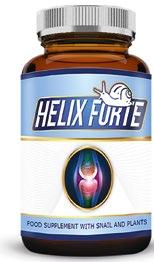
Do you suffer from osteoathritis or have you only a mild case?
See what Helix Original can do for you;
• It can rejuvenate the skin.
• It can fight high blood pressure.
• It can lower cholesterol.
• It can relieve stomach problems.

Dr. Stepanos explains how Helix Original Capsules fights the 7 causes of osteoarthritis and its consequences (pain and difficulty moving).
1) The primary cause of osteoarthritis is related to poor cartilage nutrition. The glucosamine in Helix Original Capsule nourishes cartilage (it is also their raw material and source of energy)
2) The second cause is associated with insuffcient cartilage hydration. Glycolic acid hydrates the cartilage, working like a real magnet to attract liquid into the joints.
3) The accumulation of dead cells in the joints causes continuous pain. Allantoin removes there residues and also has a repairing effect on cartilage.
4) If your joints are causing you pain, it is because they are no longer “lubricated”. The collagen in a Helix Original Capsule is a kind of oil in the form of a gel that helps your joints regain their flexibility and mobility.
5) We all know that the vertebrae are separated by discs. When these deteriorate, pain starts to build around them and can become very painful. The chondroitin in our elixir nourishes these discs, enabling them to absorb the impact from walking and exercise.
6) As its name suggests, Helix Original Capsules elastane can restore elasticity to the joints.
7) It is obvious that with age, our bodies react more slowly. Vitamins A, C and E release anti-ageing agents, in addition to their powerful anti-inflammatory action.


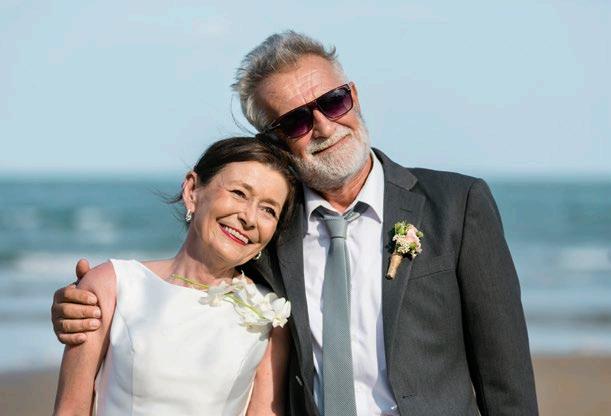


SENIOR EDITORS Anna Walker, Eva Mackevic
EDITORIAL ASSISTANT Jessica Lone Summers
ART DIRECTOR Richard Cooke
ADVERTISING Jigs Pankhania
MARKETING Sarah Hughes
HEAD OF FINANCE Santwana Singh
FINANCE MANAGER Irving Efren
MANAGING DIRECTOR Julie Leach
CHAIRMAN Gary Hopkins
subscriber enquiries, please
WE PAY...
£50 for the star letter and £30 for regular letters.
Email readersletters@readers digest.co.uk or go to readers digest.co.uk/contact-us
WE ALSO PAY...
£30 for the true stories, anecdotes, jokes in Laugh! and You Couldn’t Make It Up…, and contributions to end-ofarticle fillers and My Great Escape.
Email excerpts@readersdigest.co.uk or go to readersdigest.co.uk/contact-us
We cannot acknowledge or return unpublished items or unsolicited article-length manuscripts. Do not send SAEs. Article-length stories, poetry and cartoons are not requested.
TRUSTED MEDIA BRANDS INC (USA)
President and Chief Executive Officer
Bonnie Kintzer
Editor-in-Chief, International Magazines
Raimo Moysa
number below
Contact Customer Services for renewals, gifts, address changes, payments, account information and all other enquiries. Call 0330 333 2220* or email customer_service@readersdigest.co.uk
Reader’s Digest is also available in audio and accessible etext editions from RNIB Newsagent, for blind and partially sighted readers. Call the RNIB Helpline on 0303 123 9999 or visit rnib.org.uk/newsagent
Annual subscriptions are available to be delivered monthly direct to your door. For our latest offers please visit readersdigest.co.uk/subscribe Or telephone us today on 01778 392461
Gift subscriptions also available. UK rates may vary. Overseas rates: Republic of Ireland €50, Rest of the World €60.
READER OFFER
15% OFF HEALTH SUPPLEMENTS FOR ALL OUR READERS
If you need an easy and convenient way to get more greens in your diet, why not try Prime Fifty’s new e ervescent super greens tablet which is the first of it’s kind available in the UK. It’s received great reviews for its well-researched ingredients list, ease of use and superior taste – with a melon and lime flavour which makes it an altogether tasty and refreshing drink that you can take daily. £23.00 for a 1-month supply.


TAILORED TO THE 50+
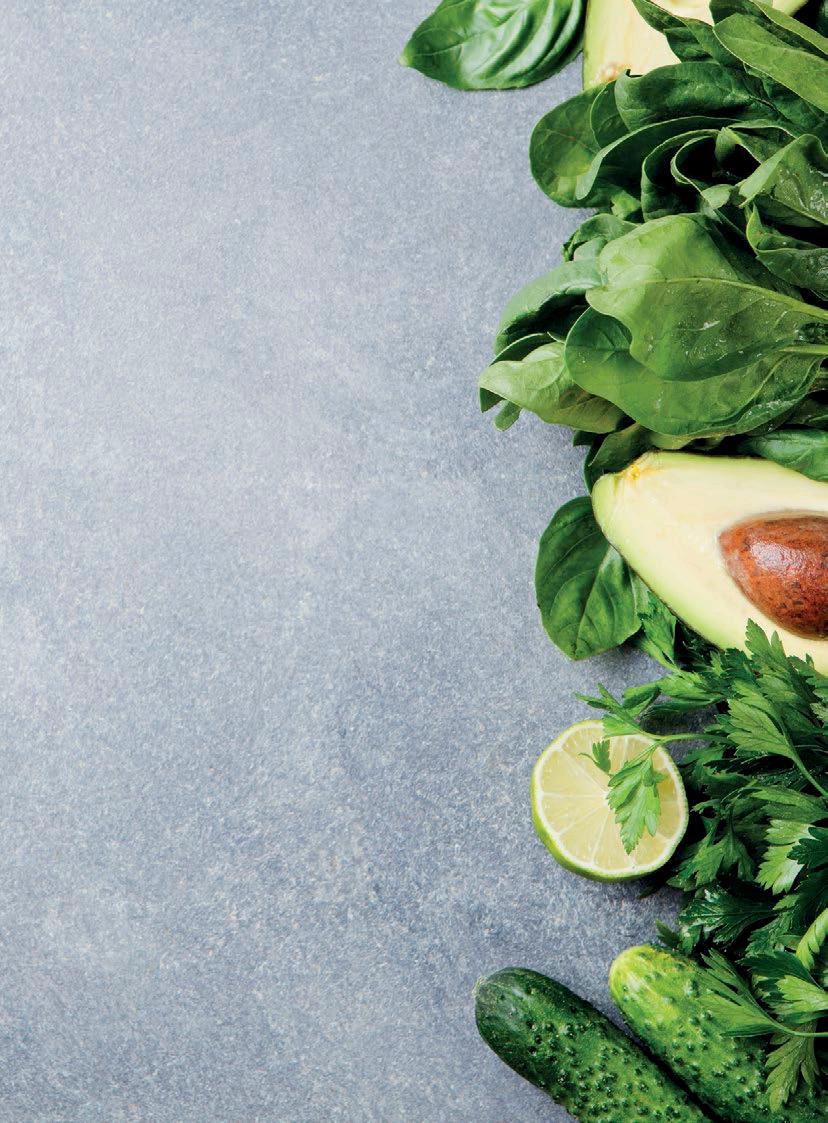
RECEIVE 15% OFF YOUR FIRST ORDER
USING CODE DIGEST15









Designed to nourish and protect your skin, hair & nails from within - these “Beauty from Inner Health” supplements have been exclusively formulated by Prime Fifty to meet the unique needs of the over 50s. Created to supplement your diet using an age-specific multi-nutrient formulation, comprising the most essential vitamins, minerals and natural extracts to help you feel good in the skin you’re in. £65.00 for a 3-month supply.






What a year we’ve had.
As December approaches and we begin to reflect on the year past, many of us will be gearing up for 2021 with plans for enhanced personal security, with COVIDrelated redundancies or financial losses becoming a reality for so many.
To mark this difficult time, from next month we’ll be launching our new money advice column, “On the Money” with our financial expert, Andy Webb. If you have money woes and need some expert, impartial advice, email onthemoney@ readersdigest.co.uk and your question could be answered in our December magazine. We’re living through difficult times, but hopefully the stories in our pages can provide you with a laugh, space for reflection or simple escapism.
On the surface, the changing nature of the world has given some of us the opportunity to nurture our talents and start those projects that we never get around to. In reality, just surviving the isolation is an immense success.

If you need inspiration to get cracking on building that rec room though, look no further than the case studies of three Syrian refugees (p82), who not only survived by escaping the cruel horrors of their homeland, but used that rejuvenated existence to thrive in their new land. For those short on time and inclination, we definitely don’t recommend the route our accidental savants (p56) took to develop their astonishing talents: head trauma. I think I’ll stick to picking up my trumpet and practising. If not today, then definitely tomorrow.
We pay £50 for Letter of the Month and £30 for all others
Robots have never been my favourite thing but, after reading “Say Hello To Your New Carer” I am totally won over.
Humans can only do their best under difficult circumstances, but with the help of a robot which can store data on each individual, not become impatient when there is little or no response from a patient (and then eventually make contact) the progress could be inspiring.
Of course, we know that humans are in control, but what a boon to have all the things you need to know contained in the super brain of the robot. The tedious notes written down and filed away are immediately available to the robot which is programmed to recognise changes and improvements which the controller can refer to electronically, and make the necessary adjustments.
It may not sound “hands on” but it is, because the experts can spend more time with each patient.
These wonderful inventions LETTER OF THE MONTH
I was enthralled while reading “Say Hello To Your New Carer”.
It would appear that robots are increasingly becoming a feature of our care services, capable of fulfilling a number of roles from manual tasks through to social interaction. Their wider use has been heralded as an important tool in dealing with our impending care crisis. Countries such as France and Japan see robots playing a key role in filling their workforce gaps in care services.
Ultimately though, carer robots will augment rather than replace human carers, as robotics could never replicate the companionship that comes from a flesh-andblood carer. Not even the most advanced simulation of a person by a robot could truly mimic a human being.
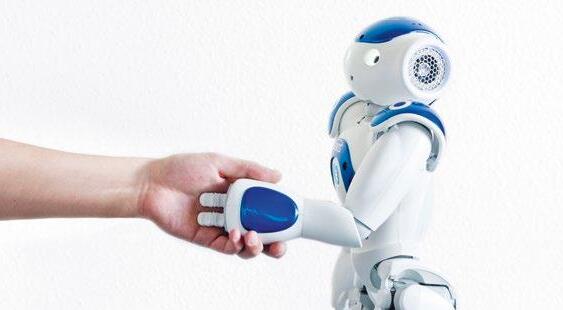
JEENA SUMNER, London
I was most grateful for your Money Feature “What to Do If You’re Worried About Your Job”.

Although I have been receiving some furlough money, it looks unlikely I will get my job back in admin at the school I’ve been working for 22 years. The economic impact from coronavirus is obviously causing untold misery to many, and there will be a large number of job losses over the coming months, so I know I am not alone.
It’s likely that we’ll see an increase in redundancies, as some companies scale down the number of employees on their payroll to cut costs, and others may go out of business altogether. So, learning more about what my rights are was most helpful. And you made me realise I need to create a budget—reviewing all my expenses and seeing what I can cut.
I’m going to tighten as much as I can, because no one knows how long this pandemic will last.
Many thanks for all the invaluable information. I feel more prepared now.
ROWENA MCMULLEN, WirralWhat a lot of sense Peter Frampton talked about in “If I Ruled the World”, especially when he mentioned that religion should not cause tension.
Sadly, religion has been a major feature with historical conflicts and modern terrorism. It has taken on extra significance today because globalisation is challenging and changing everything. Religious identity not only survives but can take on heightened significance when national and political alliances break apart.
For example, in the former Yugoslavia in the early 1990s, when Serbs, Croats and Bosniacs were divided along Orthodox, Catholic and Muslim fault lines.
Few topics cause as much drama as arguments that break out over religion. But it should be possible to talk to one another, and even to learn more about someone’s beliefs, without having to resort to disrespect or yelling.
ADAM BURTON, DenbighshireThere were ups
You’ve made a mark
There were downs
You’ve lived
Perhaps more than you realise
Triumphs Failures
And children
And now grandchildren
It’s time to tell your story
Love, laughter, tears
The gift of a lifetime
LifeBook is the world’s leading autobiography service. Around the world more than 8000 people already enjoy owning the life story of someone they love. Each book is a unique piece of family treasure, custom-made and handcrafted, to be shared by generations to come. It’s time to tell your story.
Find out how by contacting us on 0800 999 2280 or visit lifebookuk.com



37-year-old Arun Kumar Bajaj from Patiala, India has a very unusual skill—he can paint with a sewing machine. Technically, it’s embroidering, not painting, but his artworks are so incredibly detailed that they could pass as hyperrealistic paintings to the untrained eye. And the fact that he does it all with a sewing machine just makes it that much more impressive.

This month Olly Mann comes to terms with a surprising diagnosis
There’s only one health story in town, of course, and that’s my ongoing foot injury. I can’t imagine how you’ve survived the whole month since my last column without (at the very least) a press conference about it. You must be on the edge of your seats! "Will Olly’s tendonitis have retreated?", you discuss over dinner. "Or will his swelling have increased?"
Well, prepare yourself for a curve ball, because guess what—that nasty red hump under my big toe wasn’t tendonitis at all, but gout. Gout!

Olly Mann presents Four Thought for BBC Radio 4, and the award-winning podcasts The Modern Mann and Answer Me This!
I know, shocking news. Pour yourself a stiff drink to recover! (Or don’t, if you’re susceptible to gout. Which you might be. I didn’t think I was. But after six weeks of waiting for a foot X-Ray on the NHS, I buckled and consulted a private GP, who diagnosed it in an instant).
In as much as I had ever considered the condition, I had imagined that gout was strictly for portly Victorian gentlemen with sideburns, or blokes in shell-suits who subsist solely on beer and crisps. But then the doc scribbled down a list of trigger foods, and suddenly the diagnosis didn’t seem so unlikely.
"Red meat is to be avoided," he said. But we’ve just got a new barbecue! Those ribs from Costco won’t smoke themselves! "And don’t
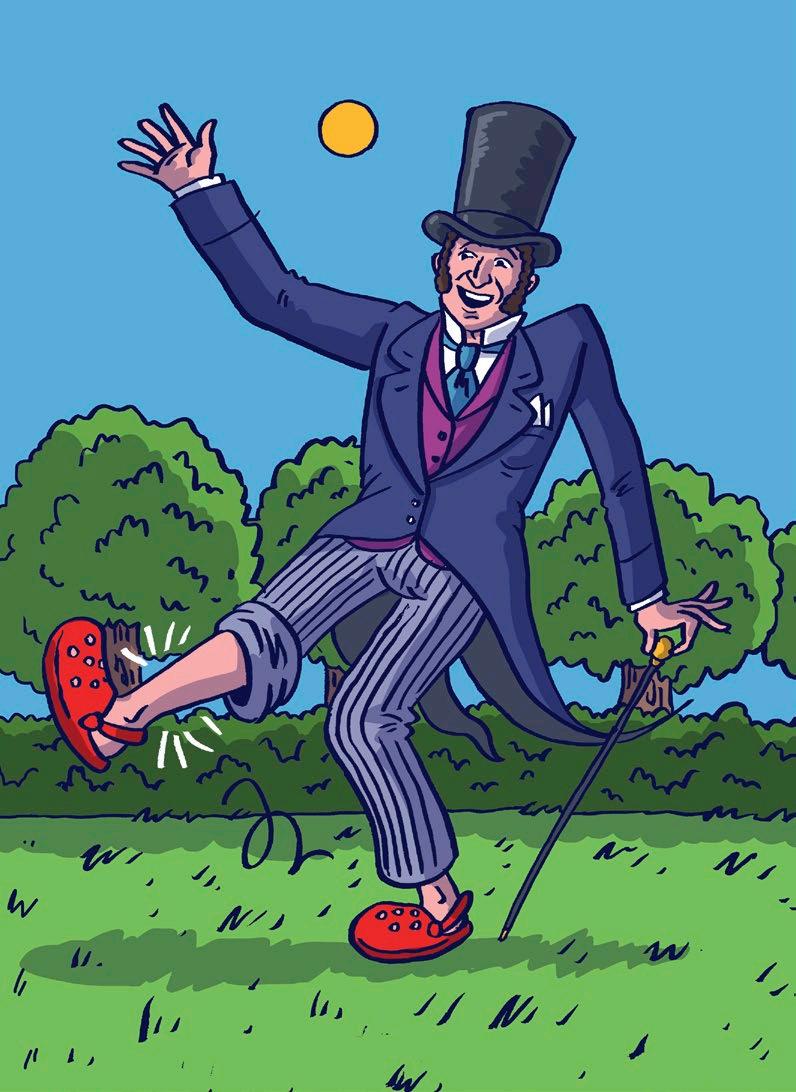
drink coffee excessively." OK, so that coffee beans subscription may not have been the best idea… "Cheese is especially problematic. Just a small slither occasionally." Hmm. Since M&S arrived on Ocado my order has been 29 per cent cheese.
"Chickpeas should be eaten only in moderation", he continued. Chickpeas? Hummus is my favourite lubricant and the thought it could do me harm hit me like a Dear John letter. "Spinach should be wilted, not raw." Eh? We all know raw spinach is good for you! Literally nobody eats raw spinach for fun! Are you telling me I could have been gobbling back chips, and that would have actually been better for me? "Eggs are fine, but not too many." We’ve got chickens as pets! "Too Many Eggs" is our way of life. Too Many Eggs could be the title of my memoirs.
"And really", he concluded, "you must cut down your alcohol consumption." This was the hardest bit to hear, because, frankly, with two kids, winter round the corner, and a pandemic to pull through, the prospect of my nightly glass (or two, or three) of wine had really been helping me get through the afternoons.
But I knew, deep down, that the anticipation ahead of the first glass of the evening was a signal of increasing dependency.
He prescribed me a small course of Etoricoxib, and, in a mere three days, the throbbing pain I’d endured for six weeks subsided. Next, I did what a lot of folks do after receiving bad news: I bought some shoes. Not a sparkly pair of Jimmy Choos, mind: some Crocs. If this is going to be a recurring problem, I reasoned, Poppa’s gonna need some brand new sandals. For weeks I’d been traipsing around in my "bin shoes"—some truly appalling £10 plastic clogs I’d got from Sports Direct specifically for taking out the bins—

only shoes I owned that my bloated hoof could only acceptable footwear for kitchen assistants, or kidney surgeons, or anyone who works in a place where their feet comes contact with offal, but I found some smart(er) navy blue ones, with a little red stripe around the bottom and no visible
felt instantly more zen. I was still wearing Crocs, yes; but at least I didn’t smell of bin.
The next step, obviously, was to spaff 50 quid on some vegan cookbooks. "Got gout, have you?", said the Waterstones guy. "So’s my mother-in-law. Can’t eat scallops." Then off to Holland & Barratt for a container-load of cherry juice. "My husband’s got gout," said the cashier. "He’s only 45!"
Virtually everyone I told replied they knew someone with gout. Rarely someone very old, or especially overweight, or nutritionally deprived: merely an individual whose body produces too much uric acid from the purines in their diet. Indeed, it turns
out the majority of gout patients are men between the ages of 30 and 50— so I’m smack-bang in the middle of the demographic.
Adapting my diet has been tough (I’ve cut alcohol to two nights per week, my coffee consumption to two cups per day, and gone veggie four days per week.) But I live in the countryside, and the idea of my toe joints becoming so damaged that it might affect my ability to walk through the fields is one hell of a motivator. I don’t miss carbonated soda, overnight oats are a revelation, and it turns out red meat and cheese taste even better as an occasional treat. Now I just need to work on growing those sideburns… n
These three minor lifestyle adjustments will make a big difference to your carbon footprint
Wash your clothing in cold water. Doing two loads of laundry on a cold setting once a week instead of hot or warm water can save a whopping 500lbs of carbon dioxide emissions each year.
Change any incandescent light bulbs in your home to LED bulbs. Although they're initially more expensive to buy, they last 25 times longer and only use a quarter of the energy.
Stop the road rage. Studies have found that aggressive driving, with unnecessary braking and acceleration, can result in 40 per cent more fuel usage than consistently calm driving.
Source: blogs.ei.columbia.edu/2018/12/27/35-ways-reduce-carbon-footprint
Supermodel, singer, and former First Lady of France, Carla Bruni, opens up about her many lives…
Carla Bruni is playing a guitar down the phone from Paris. “Can you hear that?!” she asks, with glee in her voice. “Michelle Obama gave me this guitar when we met for NATO. It’s a fantastic Gibson guitar and I have it here in my studio. Then I invited her for lunch at the Élysée Palace and I played a Beatles song for her on the guitar. I loved her. She was so kind, so open, so cool.”
Carla’s sense of wonder at having been given such a thoughtful and generous gift by America’s First Lady reveals a lot about her. She is, after all, a former First Lady herself—her husband, Nicolas Sarkozy, was President of France from 2007-12. But there’s no sense
of self-importance from her. On the contrary, Carla comes across as endearingly shy, with a down-toearth vibe that belies her own status as a public figure: one who’s already lived through several successful incarnations—as supermodel, singersongwriter and politician’s wife.
It’s Carla’s singing career that brings us together today. She’s just released her sixth album, Carla Bruni . She writes or co-writes her own material, a collection of tunes that showcase her smoky nightclub voice and place her in the great tradition of the French chanteuse.
Carla says COVID-19 gave her ample time to finish the album in the south of France after the family decamped to their summer home there for several months of


lockdown. Bruni has a 19-year-old son, Aurélien, from a relationship with French philosopher and TV host, Raphaël Enthoven, and daughter Giulia, aged nine, with Sarkozy, who also has three sons from previous marriages.
The lockdown summer house was almost overflowing. “The children were around all the time, and my sister [actress Valeria Bruni Tedeschi], my mother, who’s 91, and my aunt, who’s 95, were there, too, so we were very much in quarantine because of being with very old people who could be in danger.”
“There were people everywhere, but I found myself a room and basically I would work at night. I did a little exercise and cooking and then life became so strange. Writers and songwriters are naturally confined because we have to do our job alone, but this was a very anxious type of confinement. Writing was a release and a sort of a shelter and also a pleasure. It was good to be able to work.”
Bruni surprised everyone in 2002 when, after more than a decade as a supermodel, she released her first
Carla Bruni walks for Versace at Paris Fashion Week, 1996album, Quelqu’un m’a dit [Someone Told Me ] which reached number one in the French charts. It’s a success by any standards, but in keeping with her self-deprecating character, Bruni is modest about her singing skills.
“I don’t think I have such a good voice,” she says, with what sounds like a Gallic shrug in her voice. “I was doubtful about my voice for a very long time. Billie Holiday, Whitney Houston, Aretha Franklin— they are the singers. Even now you have Lady Gaga, Adele and Beyoncé with these big, fantastic voices.
“I thought you had to be Celine Dion, but then I discovered many women who sing with different voices, like Francoise Hardy, the bossa nova artists, people with sweet and tender voices like Dusty Springfield. So I thought the important thing is to have your own voice. It took me a while to feel legitimate.”
intention of becoming a singer.
Instead, her lithe stature, feline eyes and to-die-for cheekbones landed Carla a modelling career and she became one of the Nineties’ gang of supermodels alongside Cindy Crawford, Naomi Campbell, Linda Evangelista and Christy Turlington. A jet-set lifestyle ensued and she had relationships with Mick Jagger and Eric Clapton.
“The important thing is to have your own voice”
Born in Turin to an industrialist and music composer father and concert pianist mother, Bruni had music in her veins. The family moved to France when Carla was eight and she was educated in Switzerland and Paris. As a child she sang and wrote songs, but with no
“It was loads of fun,” says Carla of that era. “Now that I look back, maybe time gives a shadow of sweetness and everything looks good. We did so much travelling and so much work. It’s such a lucky job. You don’t have to study, you get to travel and you become celebrities. Doors opened for us.” Carla remains very close to Campbell and stays in touch with many of her former catwalk buddies. “I did a song for Christy Turlington’s charity, Every Mother Counts, and Linda Evangelista came to my show in New York City. All these people are in my heart like a family.”
Yet even when busy on the catwalk, behind the scenes she was composing music. “Naomi told me the other day, ‘I remember you singing songs on a bed in your house
“I didn’t feel that I was quitting modelling— modelling was quitting me”
in the south of France,’” says Bruni. “I sang my songs to all my friends and my sister and my mother. They were my audience. Then I stopped judging myself. I was already 28 years old, maybe 30 and I thought, Well, let’s try to record some songs. Let’s do it.”
She says modestly that her career switch was born of necessity. “I was nearly 30 and fashion needs new faces. I didn’t really feel like I was quitting modelling, but it felt modelling was quitting me. It’s a very fulfilling job, modelling, in that there’s a lot of travelling and running around. When that stopped, I had some empty time and I thought, Let’s not have a nervous breakdown—let’s make an album .”
Carla freely admits that despite a certain natural shyness, she craves the limelight. “It’s not that

I really like celebrity, but there’s something inside myself that feels good about being acknowledged by people,” she says with refreshing candour. “I believe people like me that choose these kinds of jobs do
Former top models Carla Bruni (L), Claudia Schiffer, Naomi Campbell, Cindy Crawford and Helena Christensen during the Versace Spring/Summer show at Milan Fashion Week, 2018
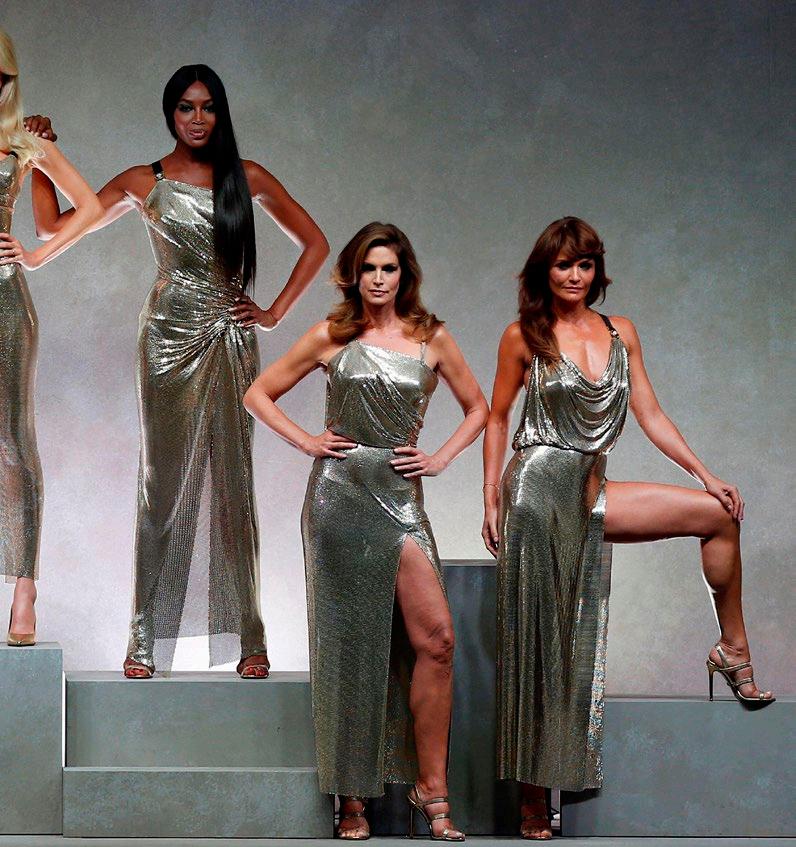
have something inside that needs to be loved or considered by as many people as possible.”
“So I find it really strange when people complain about being famous, because you can’t become
famous without wanting it a little bit.” Advice from Mick Jagger to invent a stage persona worked in helping Bruni to overcome stage fright: “Now I adore singing in front of an audience.”
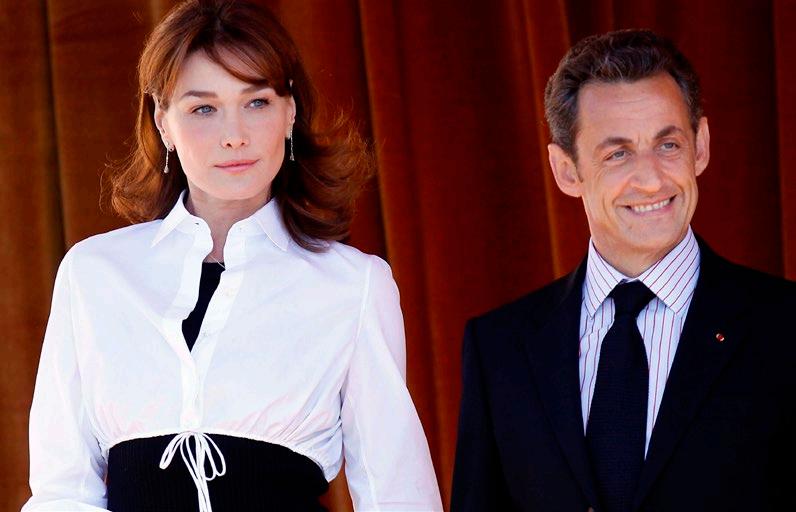
 (Top); Nicolas and Carla Bruni Sarkozy in 2009 (Below); Singing live
(Top); Nicolas and Carla Bruni Sarkozy in 2009 (Below); Singing live
Carla has said her husband is totally supportive of her career, but she doesn’t mention him in our interview, even when I ask pointedly whether her new song “Un Grande Amour” was inspired by her own life. Instead Bruni offers that she was “thinking about all forms of love. It’s a song that reminds us that love is the most important thing.”
Bruni and Sarkozy’s romance stunned everyone when after a whirlwind threemonth romance they married in February 2008, Sarkozy newly divorced and less than a year into his stint as President of France.
Though accustomed to the spotlight, Bruni didn’t find the role of First Lady plain sailing. “It was fantastic, extraordinary and very stressful,” she says. “You’re always afraid you’re going to make some sort of mistake. As a singer or even as a model it can be bad, but now you’re representing a whole country. France is not like the USA, though; it’s not a couple that is elected, it’s a person, so the wife or husband— I hope one day to have a woman in charge over here—has to be very much behind [the President].”
the guitar that she’s playing down the phone. I venture a question about ageing as a pop star—she’s 52. “You know what?
I think it’s so unfair. I think we’re having more power as women and that women are so much stronger. Look at cosmetics—big companies use women from 40 to 80 now, like Julia Roberts, Julianne Moore, Jane Fonda. But, still, it’s difficult to age with a public image. Even without a public image it’s boring and annoying; it’s not nice even if you’re just at home with your own body! I hope that they find a pill against ageing… and COVID.”
“I hope to one day have a woman in charge over here”
Bruni seems to have found her groove later in life. She found her true calling of music at the age of 30, got married for the first time at 40 and had a child at 43.
“It’s so true,” she says with a chuckle, adding: “I work and it takes me a while to find what I want to do. Then it gives me great pleasure.”
She laughs: “I hope that death will come late, too!” n
The only relic of her political life is
The album Carla Bruni is released on October 9 via Wrasse/Universal. Visit carlabruni.com for more information



Keyboard legend Rick Wakeman came to fame in the 1970s as a member of Yes and has since released more than 90 solo albums. He looks back on his West London childhood, working with David Bowie and eating curry on stage
…I LOVED CRAWLING
BACKWARDS AS A KID. I learned to talk very young, I could read before I went to school but I walked late; I was about two and a half before I even bothered to get up. But I can vividly recall crawling backwards and getting stuck in a chest of drawers. When I later asked my mum if that was true she said, “You did it all the time and we always had to drag you out.” With hindsight it was actually logical because if you’re looking at
something and you want to see what’s around it, you step back.
…DAD WORKED FOR A BUILDING SUPPLIES COMPANY and Mum worked as a secretary for a removal firm. I was born in 1949 in West London and they didn’t have much money but then again nobody did after the war. I remember Mum’s excitement when oranges appeared in the shops as there was still meat and clothing rations right through to the mid-1950s. So it wasn’t easy at

all, but at the time it was perfectly normal for everyone.
…WE LIVED IN A LITTLE SEMI IN NORTHOLT PARK. There was no central heating upstairs and it got really cold in the winter. I had great fun seeing if I could get the ice on the window in my bedroom off in one lump and even though we didn’t have a lot of money, there was always food on the table and every year we went on holiday to Devon. We had two weeks each year at Mrs Clarke’s guest house, Lawn Road, Exmouth. It was 180 miles door to door and it used to take about 14 hours, with a
few stops along the way, and it was very exciting arriving in Devon, because when you got out of the car everyone spoke in a different accent.
…OUR HOUSE WAS FULL OF MUSIC. Before the war, Mum and Dad ran their own concert group. Dad played the piano, my mum, Aunt Esther and Aunt Olive sang, Uncle Laurie was a comedian and Uncle Stan played the ukulele, the banjo and did George Formby impressions. They used to perform in village halls and church halls. Then, when all that dried up after the war, they’d somehow all squeeze into our

tiny front room and redo their act. I’d get out of bed and climb down the stairs to listen. It was absolutely wonderful and all I wanted to do after that was make music.
…I STARTED PIANO LESSONS WHEN I WAS FIVE. I worked my way through all the grades and eventually got a scholarship at the Royal College of Music in 1968. I left after a year and a half on the advice of a professor. I’d started working as a session musician and it was interfering with my college work, so he said, “You’re being trained to be a professional musician and doors
are opening for you. Go through the doors. You only get one chance.”
…ONE OF MY FIRST JOBS WAS PLAYING ON DAVID BOWIE’S “SPACE ODDITY”. That was in 1969 and he wasn’t the huge star he’d eventually become. I played the mellotron on that record, then afterwards David took me for a drink in The Ship in Wardour Street and said, “I’ve heard your piano playing. Would you like to do some piano for me?” I played on several tracks after that and he was a really lovely guy and unbelievably focused on music, art, fashion, everything. He was a

doer and he hated what he called could-haves. If anybody said to him, “I could have done that” he’d say, “Then why didn’t you?”
…I ENDED UP IN YES BECAUSE OF AN INTERVIEW I DID IN MELODY MAKER. I said that progressive music needed to be more orchestral and that the answer to that was using keyboards. They said, “We really fancy going down that route, so do you fancy joining the band?” I went along to a rehearsal, got on great with them, but then Bowie told me he was forming a band called The Spiders From Mars and asked me to
be in it. It was 1971 and by that point Bowie was a massive star, but Yes were a growing band and I knew if I joined them I’d be more of a participant in the music-making.
…WE WORKED NON-STOP, TOUR AFTER TOUR AFTER TOUR. We were living in each other’s pockets and when you have five people from completely different social backgrounds, you’re never going to be great friends. The only thing we had in common was what we wanted to try and achieve with the music so when the music started heading in what I thought was the wrong
Rick (far left) with Yes in 1974
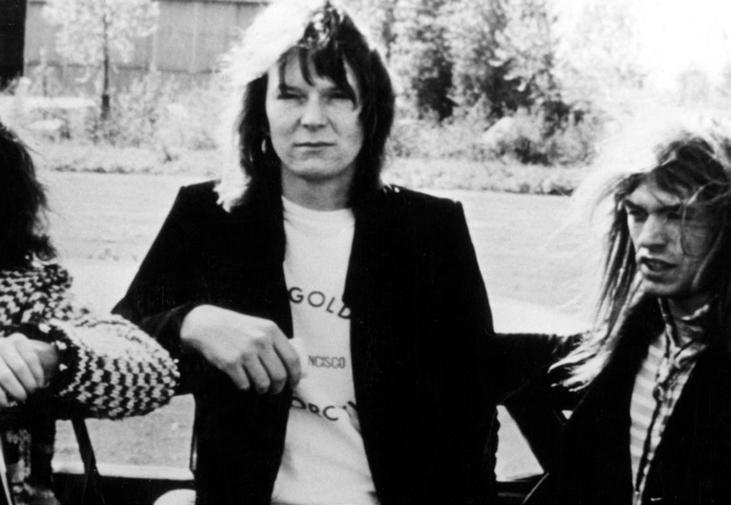
direction with Tales From Topographic Oceans in 1973, I decided to quit. I’ve been in and out of the band since, and it’s better now because we’ve learned to give each other space and not to be in each other’s pockets.
…I HAD A CURRY DELIVERED TO ME ON STAGE on the Topographic Oceans tour. My roadie, Toby, used to sit under the organ and hand me drinks. He misheard me when I said I was having a curry after the show. Twenty-five minutes later he was there with chicken vindaloo, bhindi bhaji, Bombay aloo, pilau rice,
stuffed paratha and six popadoms. I said, “I meant after the show” but when he pointed out it would get cold, I laid it out on top of the organ and ate it. Jon Anderson came over and had a popadom but the rest of the band were not amused.
…I HAD TO FINANCE JOURNEY TO THE CENTRE OF THE EARTH
MYSELF. My first solo album, The Six Wives of Henry VIII, which I made while I was still in Yes, had been a big success but my contract paid me around £4,000 per album and that wouldn’t have even covered one orchestral rehearsal. I threw in all the
With former wife, Nina Carter and their daughter, Gemma, March 1983

money I’d made from Six Wives with the permission of the wife at the time, I must add—and begged and borrowed anything I could, then I did it as a concert recording because it was too costly to do it in a studio. If it hadn’t have worked I’d have gone bankrupt but thankfully it was hugely successful.
I never took drugs but I was a heavy drinker and smoker and in the build-up to performing Journey at Crystal Palace I don’t think I went to bed for about seven days. Soon after the show I keeled over and after
being admitted to hospital they told me I’d had three heart attacks. I was in there for nine weeks and they told my manager I should retire but I was like, “Sod this, I’m only 25 years old.” So I told my manager to book me a tour of America and off I went.
but eventually built back up to where I was before, which was not the brightest thing to do, admittedly. I did quit smoking in 1979 but I was still drinking heavily and in 1985 I was really ill with alcoholic hepatitis. When the doctor gave me six months to live I gave up alcohol
there and then and I haven’t touched a drop since.
I WAS IN MY TWENTIES. I have six children and when the first few came along I was a father for a couple of weeks at a time, then I was off on tour again. I’ve been married four times and Rachel [Kaufman, 46] and I have been together 18 years now. She was a journalist who came along to interview me and at that point, I’d decided I’d had enough of women, thinking, I can’t keep giving houses away. We became good friends, then one day she asked, “Are you going to ask me out properly or what?”
I said, “Well, you’re considerably younger than me.”
Her answer was, “I don’t care, do
you?” And we’ve been together ever since.
MIND. I’ve been interested in astrophysics since performing at the STARMUS Festival and meeting the astrophysicist Garik Israelian. I’d been searching for a good concept for a new album and when he told me 2021 marks the 50th anniversary of man reaching Mars, I thought, Say no more! I did loads of research and discovered the rain on Mars is a form of dry ice so I thought, It doesn’t get any more 1970s rockand-roll than dry ice. n As told to Simon Button
Rick Wakeman’s new album, The Red Planet is out now
Relish a bad old joke? You’ll love these extra-cheesy puns
When is a door not a door? When it’s ajar.
What did the big bucket say to the little bucket? “You look a little pail.”
What’s a polygon? A dead parrot.
Who was the first person to wear a shell suit? Humpty Dumpty.
Which cowboy lives at the bottom of the sea? Billy the Squid.
Where do generals keep their armies? Up their sleevies.
Why was six frightened? Becasue seven eight nine.


A NEAR tragedy has led to an amazing new development in sleep technology. When Georgia Miles was recovering from a serious accident, her father Alexander looked around everywhere for a pillow that would keep her comfortable throughout the night. A er examining countless types, Alex, a furniture and domestic product designer, decided to engineer his own.
He made a breakthrough when he realised that all pillows spread out and atten down as the weight of the head rests on them. is attening progresses through the night, leaving the head and neck poorly supported – and sleep interrupted.
is is why many people nd themselves half awake and ‘pillow-punching’ in the middle of the night, desperately trying to get comfortable.
e innovative model that Alex designed has internal ties that hold the lling in place, and pull the pillow in and up to cradle the head and neck. is provides extra comfort and support that lasts
“I can honestly say that your pillow has made the world of difference… and fully endorse your pillow as being quite unique in its ability to maintain support throughout the night.”
through the night and ensures that you get the most bene t from an undisturbed sleep.
One of Britain’s best loved actors, Rula Lenska, was su ciently impressed to respond: “It is rare that something advertised as unique and life changing turns out to be true!! I have a chronic back and neck situation and I can honestly say these pillows make a HUGE DIFFERENCE!!! Comfortable... supportive... and positively magical for my neck!! Congratulations! A pillow that makes a real di erence!!”
Made in Britain, the Gx pillow comes in a choice of two levels of support: Medium-So , which most people seem to prefer, or Medium-Firm for those who like a little more resistance. e pillow has already transformed the lives of thousands of people. So if you have spent a lifetime looking for the perfect pillow, your search may well be over!
INFORMATION: gxpillows/0800 316 2689
CALL FREEPHONE
9am to 6pm Mon-Sat
Or order online at
To order your great night’s sleep www.gxpillows.co.uk
Orthopaedic Surgeon, Dr Deane Halfpenny


















uspension Pillow uspension Pillow









You too can sleep better! Many of us have bought pillows without finding the right one because most conventional pillows, whatever their filling, flatten throughout the night. This can lead to disturbed and broken sleep. The Gx Suspension Pillow is different. It keeps its shape and cradles the neck and head for an undisturbed night. The Gx Suspension Pillow will change the way you sleep so you wake refreshed, rejuvenated and ready for the day.
You too can sleep better! Many of us have bought pillows without finding the right one because most conventional pillows, whatever their filling, flatten throughout the night. This can lead to disturbed and broken sleep. The Gx Suspension Pillow is different. It keeps its shape and cradles the neck and head for an undisturbed night. The Gx Suspension Pillow will change the way you sleep so you wake refreshed, rejuvenated and ready for the day. Single
The pillow has evolved
The pillow has evolved
With the Gx Suspension Pillow, the unique ‘double X’ internal ties resist the flattening by pulling the pillow in and up to give the extra comfort and support that so many of us are looking for. Rediscover a great night’s sleep.
With the Gx Suspension Pillow, the unique ‘double X’ internal ties resist the flattening by pulling the pillow in and up to give the extra comfort and support that so many of us are looking for. Rediscover a great night’s sleep.
It is rare that something advertised as unique and life changing turns out to be true!! I have a chronic back and neck situation and I can honestly say these pillows make a huge difference!! Comfortable…supportive…and positively magical for my neck!! Congratulations! Many, many thanks
Please send me the following Gx Suspension Pillows

With long-tail coronavirus recovery dominating news 2020 cycles, perhaps it's time we remembered the forgotten importance of rest for recoveryby Lizzie Enfield
Ahundred years ago convalescence was seen as a necessary part of the recovery process. The word was part of the vernacular, describing a liminal space between health and illness: a phase when people were not either "sick" nor "well" but somewhere in between.
Nowadays the word is almost obsolete and, rather than taking time to rest and recuperate, most people return to work as soon as humanely

possible. They are helped by wonder drugs like antibiotics, which, by dealing effectively with the extreme symptoms of illness, con the body into thinking it’s fully recovered when often it's only part way there.
COVID-19, a disease for which [at the time of writing] there is no preventative vaccine and no early interventionist treatment has reintroduced us to the concept of a prolonged recovery, with numerous patients claiming they are not back
TheConvalescent (1862), William GaleChequers Court

“CONVALESCENCE IS NOT JUST ABOUT WHERE YOU ARE BUT ABOUT ACCEPTING THE FACT THAT YOUR BODY NEEDS TIME TO REPAIR ITSELF”
to full health after more than 100 days. It has also seen the dusting down of the noun convalescence and its associated verb. Prime Minister Boris Johnson, for one, was reported to be convalescing, at Chequers for three weeks before he was able to return to work after leaving hospital.
The notion of convalescence is largely a Victorian construct and often involved travel to spa towns or coastal resorts to recuperate after illness. But only the wealthy could afford to do this. The poor had access to charitable hospitals, but soon returned to overcrowded
slums and this had a pronounced impact on their chances of recovery. Enter the "convalescent home", built away from cities in the countryside or by the sea and funded by social reformers and philanthropists.
By 1900 there were over 300 convalescent homes in England and convalescence became a regular feature of Victorian life and its art and literature. Characters in Jane Austen novels slip away to Bath or Eastbourne to sip broth, take the waters and breathe in lungfuls of healthy sea air. Meanwhile author Robert Louis Stevenson finished writing Treasure Island in the Swiss mountains while recovering from tuberculosis and artists like Gwen John, Degas and Tissot took on "the convalescent" as their subject, painting pale and wan looking women in lace nightdresses propped up on pillows reading.
Nowadays convalescence, defined as a gradual return to health after sickness or injury, is something of a lost art. No sooner are we past the acute phase of an illness than we are discharged, sent home and all too often expected to be up and running again in a matter of weeks.
“Convalescence is not just about where you are but about accepting the fact that your body needs this time to repair itself,” says Verity Holloway, a writer who suffers from the connective tissue disorder,
Marfan’s disease. Two years ago, then aged 32, Verity developed an enlarged aortic route and needed open-heart surgery. After ten days in hospital she was sent home. But it was almost a year before she was fully recovered.
“Initially I took three months off work and went to weekly cardiac rehabilitation classes run by the NHS but I couldn’t really manage at home as I had limited mobility and open wounds. I went to stay with my aunt in Suffolk for five weeks to convalesce. She cooked, washed and helped me exercise every day. That time and her care were vital. When you're recovering from something as major as open heart surgery, you need to accept that your body will take time to get back to normal and trying to rush this process, or push yourself because there's nobody to do things for you, will impede rather than aid your recovery.”
As the 20th century progressed, several factors began to undermine convalescence as a distinct form of medical care including the introduction of physical and occupational therapy, improvements in urban housing and advances in modern medicine.
“Convalescence and its central role in systems of health and medicine suggest that our contemporary understandings of health and illness—which often tend to
categorise patients as either “sick” or “well”— can de-emphasize or even exclude important elements of recovery,” says Eli Anders, a historian at Haverford College in Pennsylvania whose research has focused on its role within the health sector. “While modern medicine and surgery are extremely effective in addressing many acute conditions, we sometimes lose sight of the intersections between the world of medicine and the world of work. Patients may need time and space to recuperate before they are able to return to their everyday lives.”
I discovered this the hard way a few years ago when I suffered a nasty bout of pneumonia. "Take time to recover" was the instruction of my doctor but this was impossible. I had three children and work to do. I came home from hospital and carried on as before. A month later I was back in hospital with kidney failure, regretting that I had not heeded my doctor's words.
The doctor who treated me this time likened the immune system to a military unit and an infection to a terrorist attack on part of your body. The cells required to deal with the attack suddenly rush to that location and fight the infection and if you don’t rest afterwards, then rather than returning to base camp ready to fight another attack, those cells are still busy. So, if you’re exposed
to another bacteria or virus you may not be ready to fight it as effectively.
“Pneumonia is an inflammation of the lung tissue, usually caused by a bacterial infection but it can also be linked to a virus like corona”, explains Dr Swapma Mandal, a consultant respiratory physician at the Royal Free hospital in London.
“If it’s caused by a bacterial infection, then antibiotics will kill the bacteria but they do not repair the inflammation and damage to the lungs. It can take anything between one week to several months for them to return to normal after a respiratory infection of this type. But often patients start to feel better, push themselves, and then they enter a cycle of boom and bust.”
Before the advent of so called "wonder drugs", the only way to get better was to rest and allow the body to recover in its own good time.
“The long and uncertain recovery time that many COVID-19 patients have been facing serves as a reminder that patients are often not fully 'recovered' after being treated for an illness,” says Eli Anders. “Antibiotics, vaccines, and other pharmaceuticals are, of course, vital to the success of modern medicine. But our healthcare systems and culture often emphasize these and de-emphasize other forms of treatment and care that may also be vital to patients’ recovery, including convalescence.”

“THE LONG RECOVERY TIME MANY COVID-19 PATIENTS FACE SERVES AS A REMINDER THAT PATIENTS ARE OFTEN NOT FULLY 'RECOVERED' AFTER BEING TREATED FOR AN ILLNESS”
We all know the NHS is overstretched and the taxpayer is unlikely to fork out for people to spend weeks in Eastbourne taking the air, or lying outside in a Swiss sanitorium.
In the 1940s, the NHS did take over a number of convalescent homes
but struggled with how to define and operate them as it was wasn't always clear how supporting convalescence fell under the mandate of providing medical treatment and care.
Into the gap stepped spas, spa hotels and travel companies offering

“THE NHS TREATMENT I RECEIVED WAS AMAZING, BUT WHILE GETTING RID OF THE CANCER, IT LEFT MY BODY DEPLETED AND WEAK”
medical breaks , providing places to rest and recuperate for those who could afford it.
Melanie Walker booked herself into a spa after having treatment for breast cancer and described her stay there as a necessity to counteract the shock and pain of her diagnosis and treatment.
“The treatment I received on the NHS was amazing but while getting rid of the cancer, it left my body depleted and weak. I booked myself into a spa for a week and that time allowed me to process what had happened and to recognise that my body needed rest and nourishment
to begin to heal itself. It was a good space in which to recognise that and it enabled me to take things more slowly than I might otherwise have done when I went home.”
And this is perhaps what COVID-19 has reminded us of. When I had pneumonia, my husband wondered what would have happened to me had I not been admitted to hospital and been injected with infectionfighting antibiotics. The answer is that I might not have recovered at all, or that I would have had to sweat it out and been forced to take my time resting and recovering. Perhaps then I would not have succumbed to the secondary infection, which saw me back in hospital.
I can only speculate but, ask
anyone who has been forced by illness or surgery to slow down and take time out and they will tell you that, while the word "convalescence" may be almost obsolete, the concept still has an important part to play in the recovery process.
"As a historian, I’m always wary of drawing contemporary lessons from very different historical contexts, says Eli Anders. “But the long and uncertain recovery time that many COVID-19 patients have been facing certainly remind us that patients are often not fully 'recovered' after being treated for an illness, and that we should keep this in mind as we consider the design of social supports, housing arrangements, and labour conditions, upon which the ability to convalesce may depend.” n
It takes approximately 75,000 hand-plucked flowers to make just one pound of saffron, which is what makes the spice so expensive.
Chinese Five Spice isn't named for the number of ingredients, but for the five different flavours it provides—sour, bitter, sweet, salty and pungent.
The world's hottest chili pepper, the Trinidad Moruga Scorpion Chili, can burn its way through latex protective gloves.
Ancient Greeks and Romans believed that basil plants could only grow if you screamed curse words as you sowed its seeds.
Black pepper has been used to add flavour to food for over 4,000 years. In the 4th century BC it was so valuable that it was referred to as "black gold".

Here's how mindful eating could be the key to ending junk binges

Susannah Hickling is twice winner of the Guild of Health Writers Best Consumer Magazine Health Feature
Are you trying to manage your weight or a health condition like diabetes, but find yourself guzzling a tub of ice cream or a jumbo bag of crisps? Here’s how to really focus on your food so that you eat the right things in the right amounts.
Unplug those gadgets It’s too tempting to scroll through your phone as you munch your meal, but it can make for mindless eating. Studies have found that we can put away as much as a whopping 25 per cent more calories if we fixate on a phone, tablet or television at the same time. Worse still, there’s evidence that you eat more later in the day.
So put down the devices and eat at a table—preferably with a partner,
friend or the whole family. And if you’re dining alone, simply be more mindful of the food in front of you. As a result, you’ll eat less and enjoy it more—we promise.
Beware the "healthy" option Do you have a tendency to brand food good or bad and opt for prepackaged, supposedly healthy foods like cereal bars and low-fat ready meals? These meals and snacks aren’t always as nutritious as you might think, even if they seem to correspond with your diet.
Stop right there! To be really aware of the food you’re eating, pause halfway through your meal and ask yourself if you’re still hungry or whether you might be close to being full. Are you enjoying the taste and the texture of what you’re eating, rather than just packing it away?
I once went to a French wedding where the guests consumed six courses over six hours, with a break for entertainment between each one. I never felt bloated or even full.
There was something about the slow pace of the meal that made it more satisfying but less overwhelming. It takes around 20 minutes for your brain to register that your stomach is full and so if you eat more slowly you tend to eat less and feel ready to eat again sooner. You’ll also enjoy your meal more.
Of course, it’s not often you get to go to a six-course wedding reception, but the same principle applies whatever the situation: it’s good to pay heed to the rhythm of your meal by stopping to talk or by chewing more slowly.
Know what you’re really hungry for It may not be food. It’s very easy to use food—cooking or consuming it—as a distraction from stress and a busy life. If you do find yourself grazing or overeating, stop and ask yourself if you are bored, worried or depressed. Once you identify the reason behind your mindless eating, you’re in a better position to put a stop to it.
Go on the snack attack Coffee and biscuits, or a chocolate bar, especially at work, can lead to piling on the calories. Consider going for a stroll or doing some breathing exercises instead. n
For more weekly health tips and stories, sign up to our newsletter at readersdigest.co.uk
Since coronavirus, we’ve heard a lot more about chronic obstructive pulmonary disease (COPD) and how it puts you at higher risk of being more seriously ill with COVID-19. But what is it?
Surprisingly, it’s not just one disease. COPD is the umbrella term for a group of conditions that cause breathing problems. These include emphysema, in which the air sacs of the lungs are damaged, and chronic bronchitis, when the airways become narrow and inflamed.
But there’s one key cause, and that’s smoking. That’s because it causes long-term damage in your lungs. You can also develop COPD from breathing in harmful fumes or dust over a long period.
And the symptoms are the same. People who have COPD get out of puff easily, especially when they’re being active—even a walk can make you breathless. They have a “smoker’s cough” with phlegm, as well as wheezing and frequent chest infections. Symptoms get worse over time. The condition usually affects middle-aged and older people.
It’s incurable but there are treatments. There are inhalers and
medicines to help you breathe more easily. Pulmonary rehabilitation—a special programme of exercise and education—is also available, and surgery, including a lung transplant, might be a possibility for a few.
Above all, give up smoking. This is by far the most effective way of alleviating your symptoms and preventing long-term harm, including lung cancer and heart disease—having COPD puts you at higher risk of both of these. The simple message is that ciggies and COPD don’t mix.
Take steps to guard against COVID. If you have COPD, follow social distancing advice religiously, making sure you wash your hands regularly and wear a mask in enclosed public spaces, if you can. You might want to consider limiting your visits to indoor public places. Make sure you keep on top of your COPD by taking the medicines, using your inhalers and doing any exercises you have been prescribed. n
Rachael Crook is the co-founder and CEO of technology-enabled home care company Lifted, winner of Best Start-Up Home Care Service in the 2020 Home Care Awards
How did you become an authority on finding home care?
My mum was 56 when she was diagnosed with early-onset dementia. When we had a home care company come in, it was frustrating and difficult to manage. I thought, “Gosh, this experience could be so much better”, so I founded Lifted.
What are the advantages of older people receiving care at home?
Most people want to be, it helps maintain social connections and, if they have cognitive challenges, they're in familiar surroundings. With COVID, it’s safer.
What makes a great carer?
Carers need to be kind, have cared for someone before, perhaps a family member, and be passionate about caring. They must be competent— that is based on training. Being reliable is important and being proactive—often elderly people don’t want to tell you they need help. These are values we developed in consultation with families.
How can families find good domiciliary care?
Look for a provider regulated by the Care Quality Commission (CQC) and for a "Good" inspection. Read the report. Look for reviews and awards. Do companies pay carers properly?
Do they pay for time spent travelling between appointments? Ask about insurance, training and background checks. You can find companies on websites such as homecare.co.uk and caresourcer.com.
How does the home care sector need to develop so it can be really effective?
The first thing is more transparency using technology—enable families to see what’s happening when they’re not there from a safety perspective and to share the joy. Lifted has done this through an app. Second is investing in training, and paying staff properly. n
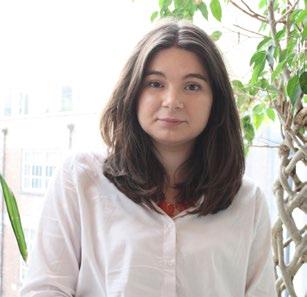
For more information, visit liftedcare.com

Dr Max Pemberton muses on the inequitable truth that money is sometimes placed before health care

Max is a hospital doctor, author and columnist. He currently works full time in mental health for the NHS. His new book, The Marvellous Adventure of Being Human, is out now
“C
an I have a biscuit please?” asked Mrs McMahon. This, you would think, is a fairly reasonable request. Not least because Mrs McMahon fell at home and lay there until a neighbour found her, so she hasn’t eaten anything for nearly 36 hours. If I was her, I’d want more than just a biscuit. “Or two, if that’s possible”. Ah, a woman after my own heart. I relayed this request to the nursing staff.
“Don’t fancy your chances of that”, replied one of them, sucking her teeth and frowning. “We’ve had some problems with biscuits, you see.” In my naivety, I thought hospitals had problems with COVID. Apparently in this particular hospital it’s obtaining any foodstuffs past a certain time once the catering staff have gone home.
“A sandwich?” I ventured. The nurse just laughed at me. At the time I was working in surgery, in one of the country’s first large-scale PFI
hospitals. It was all bright and shiny and a blessed relief from the dire Victorian buildings we’d all been used to. It soon became apparent though that PFI—short for private finance initiative—wasn’t quite all it purported to be. Under this scheme building projects and certain services are run by private companies, which the NHS then rents back off them.
One such “service” within this hospital was catering. The private company that was responsible for this, however, insisted on locking the pantries on the ward in an attempt to prevent “unauthorised consumption”. For them, the food in the pantries represented profit margins. For the patients, of course, it just represented food. Different hospitals have different arrangements and contracts, so perhaps another hospital might have 24-hour access to biscuits, but no after-hours IT support, for example. This incident became affectionately known as “biscuit-gate” because of the scandal it caused on the ward. The nursing staff and I were mortified that we couldn’t provide Mrs McMahon with anything to eat.
“I can see the tin just there”, said Mrs McMahon, pressing her nose against the glass like an orphaned child in a Dickens novel. Eventually an enterprising nurse walked to the nearest 24-hour petrol station while on her break and bought Mrs McMahon a packet of Hob-Nobs. Those who work in healthcare have
learned through bitter experiences, that PFI doesn’t work for patients. It works for the government because they avoid having to spend money on buildings and maintenance, and can
“IF WE WANT A GOOD HEALTH CARE SERVICE WE HAVE TO PROVIDE PROPER PUBLIC INVESTMENT”
put the responsibility of paying the PFI companies back on the hospital trusts. PFI in the healthcare system has shown itself to be ultimately grossly inefficient, costly, restrictive and detrimental to patient welfare. Ministers have now banned the NHS from entering into further PFI contracts, but the ones that have already been signed mean that some hospitals are forced to spend as much as one-sixth of their entire budget on repaying debts as a result of the PFI scheme. These repayments, at exorbitant rates, are why some hospitals, despite investment, still struggle financially.
The fact of the matter is, if we want a good health care service we have to provide proper public investment. With PFI, all we end up doing is paying inflated prices for sub-standard services in order to provide healthy profit margins for private companies. That really does take the biscuit. n
Q: I am 60 years old and normally very fit. However, for the last couple of months I have been feeling what I can only describe as “funny turns”—it feels like I’m walking on fluffy pillows. It’s not dizziness but a kind of drunk feeling. What could be causing it? - Ellen, 60
A: “Funny turns” are often dismissed by both patients and doctors. I think this is probably because they can be caused by so many things and often turn out to be nothing to worry about. However, when I was at medical school I was taught by a wily old professor who cautioned against dismissing these symptoms and advised that they should always be investigated.
Over my years of practising medicine, I’ve often thought of him as, time and time again, I’ve come across patients whose symptoms started off as “funny turns” and were ignored only for them to turn out to be the early warning signs of

something more serious. I say that not to alarm you, but to encourage you to get these investigated. My own mum had a number of “funny turns” which we assumed were nothing only for them to turn out to be mini-strokes (sometimes called TIAs, Transient Ischaemic Attacks). When we realised what was happening, she was put on medication to thin the blood and manage her cholesterol and hasn’t had any since, but they could have led to a full-blown stroke. She was lucky. Funny turns do usually involve feeling dizzy, or lightheaded, but not always. There are so many different things that could be the underlying cause here, I won’t hypothesise, but I do think you should go to your GP so they can take a proper, full medical history, examine you and run some tests to try to get to the bottom of it. n
Got a health question for our doctor? Email it confidentially to askdrmax @readersdigest.co.uk










Need to boost your recall?
It’s time to rhyme—says our memory expert, Jonathan Hancock
bet you’ve learned lots of things with the help of rhymes. As a child, you were probably told to “Remember, remember, the 5th of November” as a day of “gunpowder, treason and plot”. Were you also told about Columbus sailing the ocean blue in 1492, and London burning to rotten sticks in 1666? Perhaps, like me, you still find yourself hastily reciting, “30 days hath September” a few times every year.
Traditional rhymes like these are powerful memory joggers. Their simple rhythms help to package information neatly, then trigger our recall with their familiarity. And their rhyming words make it far less likely that we’ll go wrong.
But the most important factor in this kind of learning is repetition. Traditional rhymes were often chanted or used in playground games, so that children would say them aloud over and over again. And, however old we are, clear rhythms and obvious rhymes tempt us to repeat phrases and couplets—in exactly the same way each time. In doing so, we lay strong memory traces.
As a result, even though “the fourth of November” fits the rhythm of that particular verse just as well as “the
fifth,” countless repetitions have firmly embedded the right word in our brains.
It’s a great memory exercise to recall rhymes you learned in the past—including some that may not have entered your conscious mind for decades. Start with “I before E except…” Then have a go at “Red sky at night…” And keep exploring your mental archives for other handy little memory rhymes.
Why not try learning some new ones, too? Here’s a helpful verse about the weather:
Rainbow in the morning, travellers take warning / Rainbow at night, travellers’ delight!
And you can even create new rhymes for information you want to learn. Do it for things that you’ll need regularly (like your PIN, or a friend’s address). Use regular rhythms, invent simple rhymes—then say them the same way every time.
For example, to remember that your PIN is 5623:
“Cash machine, yes it’s me / “Fifty six, twenty three”
And if your friend Jackie lives at number 4 The High Street: “On my way to Jackie’s door / Down the High Street—number 4!” n
Immunace® was developed over 20 years ago by Vitabiotics’ experts. It was one of the first immune health supplements to pioneer the inclusion of vitamin D for the immune system.


Immunace® Original includes 24 vitamins and nutrients. †With vitamins D, C, zinc and selenium which contribute to the normal function of your immune system.
Immunace® Extra Protection is our advanced formula with the benefits of Immunace® Original, extra vitamin D and more.
















 Jason Padgett’s designs (facing page), the piano playing of Derek Amato (above), and Alonzo Clemons’s sculptures (above left) are all products of serious head trauma
Jason Padgett’s designs (facing page), the piano playing of Derek Amato (above), and Alonzo Clemons’s sculptures (above left) are all products of serious head trauma

In rare cases, traumatic head injuries unleash remarkable creative talents in the victims.
Is there a genius lurking in each of us?
BY Adam Piore FROM THE BOOKTHE BODY BUILDERS
Derek Amato stood above the shallow end of the pool and called for his buddy in the Jacuzzi to toss him the football. Then he launched himself through the air head-first, arms outstretched. The tips of Amato’s fingers brushed the pigskin—and he splashed through the water just before his head slammed into the pool’s concrete floor. He pushed to the surface, clapping his hands to his head, convinced that the water streaming down his cheeks was blood gushing from his ears.
At the edge of the pool, Amato collapsed into the arms of his friends Bill Peterson and Rick Sturm. It was 2006, and the 39-yearold sales trainer was visiting his hometown in Colorado. Amato’s mother rushed him to emergency, where doctors diagnosed him with severe concussion.
It would be weeks before the full impact of Amato’s head trauma became apparent: 35 per cent hearing loss in one ear, headaches, memory loss. But the most dramatic consequence appeared just five days after his accident. Amato awoke, feeling hazy after near-continuous sleep, and headed over to Sturm’s house. As the two pals chatted, Amato spotted an electric keyboard.
Without thinking, he sat in front of it. He had never played the piano—he’d never had the slightest inclination to. Now his fingers seemed to find the keys by instinct and, to his astonishment, ripple across them. His right hand started
low, climbing in lyrical chains of triads, skipping across melodic intervals and arpeggios, landing on the high notes, and then starting low again and building back up. His left hand followed close behind, laying down bass, picking out harmony.
Amato sped up, slowed down, let pensive tones hang in the air and resolved them into rich chords as if he had been playing for years. When Amato finally looked up, Sturm’s eyes were filled with tears.
Amato played for six hours, leaving Sturm’s house early the next morning with an unshakable feeling of wonder. He had fooled around with instruments in high school, even learned a decent rhythm guitar. But nothing like this. Though he knew he hadn’t suddenly transformed into US jazz pianist and composer Thelonious Monk—he wasn’t that good—Amato had accessed a well of untapped creativity and ability he had never before touched; suddenly there was

Name: DEREK AMATO
Discovered talent: PIANO
Some scientists believe that Amato’s musical skill is evidence that untapped potential lies in everyone, accessible with the right tools
music rising up spontaneously from within him, coming out his fingertips. How was this possible?
Within days of his injury, Amato began searching the internet for an explanation, typing in terms such as gifted and head trauma . He found the name Dr Darold Treffert, an expert on "savant syndrome", a condition in which individuals who are typically mentally impaired demonstrate remarkable skills. Amato fired off an email; soon he had answers. Dr Treffert diagnosed Amato with acquired savant syndrome. In the 90 or so known cases, ordinary people who’d
suffered brain trauma suddenly developed what seemed like almost superhuman new abilities: artistic brilliance, mathematical mastery, photographic memory. Dr Treffert believes that our brains come with a wide array of "factory installed" software—latent abilities that exist but we sometimes don’t have access to. The exact nature of an acquired savant’s emergent abilities depends on the exact location of the injury. That explains the wide variation in both the range of abilities found in different individuals and their various manifestations.
FOR JASON PADGETT, a futon salesman, a head injury resulted in uncommon mathematical abilities. Padgett suffered a severe concussion after two men attacked him outside a karaoke bar in 2002. When he woke up, he saw pixelated patterns everywhere—in water spiralling down the drain, in sunlight filtering through the leaves of trees. In his high school days, Padgett had been a weightlifter and party-goer who cheated on maths tests and had little interest in academics. But after his accident, he began sketching intricate geometrical drawings, attempting to capture what he saw. Padgett did not understand their significance until a physicist happened to catch a glimpse of one of his sketches. He recognised them
as highly sophisticated visual representations of deeply complex mathematical relationships and urged Padgett to enrol in maths classes. Today, Padgett is one of the few people capable of drawing fractals (meaning repeating patterns that start simply and get progressively complex).
Orlando Serrell was hit on the left side of his head by a baseball when he was ten and soon after realised he could remember precisely what he was doing and what the weather conditions were on any given day going back years.
As a young child, Alonzo Clemons suffered a severe brain trauma following a bad fall. He then developed a remarkable ability: after catching just a glimpse of an animal on television, he was able to sculpt an accurate 3D model of it. His lifelike animal sculptures have earned him worldwide renown.
Many acquired savants also have negative symptoms. Clemons never recovered from his accident. Today, he suffers from a developmental disability and has an IQ in the 40 to 50 range. Padgett developed symptoms of obsessive-compulsive disorder: he found himself washing his hands 20 times in an hour. Even so, these individuals speak of their new abilities with wonder.
How is it that a bump on the head can suddenly unleash the

Name: JASON PADGETT
Discovered talent: MATHS
Following his injuries, Padgett, who hadn’t progressed beyond pre-algebra in high school, became one of the few people in the world able to draw complex geometric patterns called fractals
muse? And what does it mean for the rest of us?
DR BRUCE MILLER, who directs the University of California San Francisco Memory and Ageing Centre, treats elderly people with Alzheimer’s disease and other forms of dementia. One day in the mid-1990s, Dr Miller spoke with the son of a patient who said his f ather had developed a fixation with painting. Even
stranger, as his father’s symptoms worsened, the man said, his father’s paintings improved. Dr Miller was dubious until the son sent him some examples. The work, Dr Miller recalls, was brilliant.
“The use of colour was striking,” he says. “He had an obsession with yellow and purple.” Soon the patient, a brainy businessman with no previous artistic interests, had lost his grip on social norms: he was verbally repetitive, changed clothes in public, insulted strangers and shoplifted. But he was winning awards at local art shows.
By 2000, Dr Miller had identified 12 other patients who displayed unexpected new talents as their neurological degeneration continued. As dementia laid waste to brain regions associated with language, restraint and social etiquette, the patients’ artistic abilities exploded.
Although these symptoms defied conventional wisdom on brain disease in the elderly, Dr Miller realised they were consistent with savant syndrome. Savants often display an obsessive compulsion to perform their special skill, and they exhibit deficits in social and language behaviours—defects present in dementia patients. Dr Miller wondered whether there might be neurological similarities, too.
He read the brain scan of a fiveyear-old autistic savant able to reproduce intricate scenes from
memory. The scan revealed abnormal inactivity in the anterior temporal lobes of the left hemisphere— exactly the results he’d found in his dementia patients. Studies suggest that parts of the anterior temporal lobe are associated with logic, verbal communication, comprehension and perhaps social judgement.
In most cases, scientists attribute growth in artistic skills to practice, practice, practice. But after his research, Dr Miller argued that savant skills emerge in dementia patients because the area ravaged by disease—the anterior temporal lobe—has actually been inhibiting latent artistic abilities present in those people all along. The skills do not emerge as a result of newly acquired brainpower; they emerge because, for the first time, the areas of the brain associated with the free flow of ideas can operate unchecked.
According to Dr Miller, in the brains of dementia patients and some autistic savants, the lack of inhibition in areas associated with creativity led to keen artistic expression and an almost compulsive urge to create. Derek Amato was no exception.
IN THE WEEKS after Amato’s accident, his mind raced—and his fingers wanted to move. He found himself tapping out patterns and waking up from naps with his fingers drumming against his legs.
He bought a keyboard. Without one, he felt anxious, overstimulated. Only when he was able to sit down and play did he feel a deep sense of calm. He would shut himself in, sometimes for as long as three days, just him and the keyboard, exploring his new talent, trying to understand it, and letting the music pour out of him.
Amato experienced other symptoms, many of them negative. Black and white squares appeared in his vision, as if a transparent filter had synthesised before his eyes. He was plagued with headaches, as many as five a day. They made his head pound, and light and noise caused excruciating pain. One day, he collapsed in his brother’s bathroom. Another, he almost passed out in a supermarket.
Still, Amato’s feelings were unambiguous. He was certain he had been given a gift. The evidence lay not just in the ease he felt when he put his fingers on the keyboard, but also in the drive he felt—the burning compulsion to play. He felt it in his heart: this was what he was meant to do.
FEW PEOPLE have followed the emergence of acquired savants with more interest than Allan Snyder, a neuroscientist at the University of Sydney. In 2012, as part of his research, Snyder and his colleagues gave 28 volunteers a geometric puzzle that has stumped

Name: ALONZO CLEMONS
Discovered talent: SCULPTURE
Savants such as Clemons can store vast amounts of information in their memory banks. Clemons can sculpt perfect 3D animals after just glimpsing them on TV
laboratory subjects for more than 50 years. The challenge: connect nine dots, arrayed in three rows of three, using four straight lines without retracing a line or lifting the pen. None of the subjects could solve the problem. Then Snyder and his colleagues attached electrodes to the heads of subjects and used painless direct electrical currents to temporarily immobilise the left anterior temporal lobe—the area of the brain destroyed by dementia in Miller’s acquired savants. At the same time, they stimulated areas in the
right anterior temporal lobe, making the neurons that were more active in the dementia patients—the ones associated with creativity—more likely to fire.
This time, more than 40 per cent of the participants in Snyder’s experiment solved the problem. The experiment, Snyder argues, supports the theory that acquired savants blossom once brain areas normally held in check have become unfettered, meaning that savants can access raw sensory information normally off-limits to the conscious mind. When a non-musician hears music, they perceive the big picture: melodies. Amato, Snyder says, hears individual notes. It’s the difference between just hearing a symphony and being able to pick out the flute. Dr Miller’s dementia patients have artistic skills because they are drawing what they see: details and not simply broad strokes.
Psychologist and neuroscientist Jon Kaas of Vanderbilt University says our tendency to “see the big picture”—to look at a bunch of trees and see a forest—makes evolutionary sense. If we allowed ourselves to get caught up in details and not the overall picture, we could get hopelessly and dangerously distracted. We might get hung up, for instance, on the shining eyes or intricate tangle of
hair on the head of the big animal by the watering hole—instead of realising it’s a lion that might eat us for dinner and that we’d better run.
“If you are in a semi-dangerous environment, it’s important to be aware of what’s changing,” he says. “You don’t want to get distracted or lost in the details.”
MUSICAL RENOWN has yet to follow for Amato, though he did release an album, performed with the famed jazzfusion guitarist Stanley Jordan, and was asked to write the score for a Japanese documentary. Still, the former anonymous sales trainer is an inspirational symbol of human possibility for music lovers dreaming of grander things.
Savant expert Dr Treffert, neuroscientist Snyder and others spoke enthusiastically about unravelling the phenomenon of acquired savant ism in order to enable all of us to explore our hidden talents. The Derek Amatos of the world provide a glimpse of this goal—untapped potential lies in everyone.
In Amato’s playing, there is expression, melody and undeniable skill. And if this can emerge spontaneously in him, who’s to say what potential might lie dormant in the rest of us? n

"What a grand, higgledy-piggledy, sensible old place Norwich is!'"
- Novelist JB Priestly


"Norwich is a fine city. None finer. If there is another city in the UK with a school of painters named after it, a matchless modern art gallery, a university with a reputation for literary excellence which can boast Booker Prize-winning alumni, one of the grandest Romanesque cathedrals in the world, and an extraordinary new state-ofthe-art library, then I have yet to hear of it." So said comedian Stephen Fry of the city he calls home. Indeed, while Norwich is often spoken of for its most famous fictional native, Alan Partridge, it lays claim to having once been the largest city in Britain after London, with its enormous cathedral, statuesque castle and beautiful medieval Tombland area still standing in testimony to the influence it once wielded over the rest of the British Isles. Today, the city is a hub of arts and culture with two universities, a modern art gallery and countless music venues making it an unforgettable place to live and visit.
DANNY KEEN, 72, arrived in London in 1952 as part of the Windrush generation. Today, he calls Norfolk home, and is a well renowned artist. He's also the chairman of Norwich's Black History Month committee.

I moved to Norfolk in 1988 from London with my family for a better quality of life. The education standards are very high in the city and my daughters went to Norwich High School. I followed friends who were artists to the region. Wherever I have lived in Norfolk, I have had neighbours who are writers, artists, musicians, performers, dancers… the cultural life of the region is rich. I started a jazz bar called the Alibi in the city centre and immediately found a wealth of world-class musicians who performed in my venue, with instant success. It was frequented by artists whose work was hung on the walls (there is a painting hanging in the City Hall depicting Norfolk’s premier artists in my bar).
When I first visited the region, there was a very visible presence of US Air Force personnel. As a West Indian, I especially liked to see the black Americans with their Cadillacs and Hawaiian shirts. But in the late 80s
they seemed to disappear overnight. However, they have left a lasting impression on the cultural life of this region and the rest of the UK, as they brought rhythm and blues, soul and jazz to this country. To this day the senior blues singer of this country is a Norwich-born resident, Albert Cooper.
I first came to the city to stay with friends for a November weekend. Despite the dull weather, on the Saturday evening the hustle and bustle of the market place was welcoming. For me, there is a tangible spiritual quality of many areas in Norwich and Norfolk. Obvious examples are Walsingham and Norwich Cathedral, but there are many other areas of the county that have a special spirit of place too.
Norwich has a long history of welcoming “strangers”. It is officially a "City of Sanctuary". In the last two or three decades, BAME communities have developed and thrived here. There have

been many success stories of people who arrived here in the most distressing circumstances imaginable. Amongst them are scientists, musicians, actors, performers and engineers who have all contributed to the enhancement of Norwich life. Within the city centre there are many historic conservation areas all with their own qualities.
Norwich and Norfolk has been a place of huge opportunity for me. I have found an outlet for all my interests.
I learnt to play jazz piano from local musicians and have had the opportunity to play in public. My studio is in the beautiful Norfolk countryside—a tranquil and inspiring environment for producing artworks. I have also pursued my interest in the martial arts and had the opportunity to train national

champions. Alongside this, I have studied the Oriental healing arts and am able to practice professionally.
It is some decades now since I created my own businesses in the catering and hospitality sector. Norfolk is the land of opportunity for the aspiring entrepreneur.

RORY HILL, 29, is the visitor and experience manager of the Sainsbury Centre for Visual Arts, a gallery and museum located on the University of East Anglia campus.
Growing up in the Norfolk countryside, my older sister and I were desperate to see the big city as teenagers! I was playing in a band full-time so it made sense to move to Norwich to be close to the music scene I was part of.
My favourite thing about Norwich is the fact that it is so unique. I was lucky to travel a lot as a musician and I played in what felt like every town and city in the UK. Norwich was always the perfect place to come home to. Just the right size, just enough going on, fun but not too crowded. An amazing history of music, literature, arts, rebellion, architecture… you name it. Geography plays a huge part too—I can walk to my job, walk in to town, walk to a nature reserve or drive half an hour to a stunning coastline. Spoilt for choice, but without the stress of a bigger city.
I think people in Norwich are proud to do things a little differently. You certainly meet a lot of people here who are excited to tell you something interesting about their city and there’s a real sense of pride and ownership in the community.
Norwich has simultaneously barely changed at all in my time here (sometimes for better, sometimes for worse!) and also transformed massively. It is and always will be an historic, medieval city packed with charm. Where I think a lot of other similar-sized places might rush to try and emulate others (ie do what’s done in London), Norwich seems happy to carve out its own niche.

Sainsbury Centre

The food and drink scene here has exploded—you can’t move for cocktails, speciality coffee, natural wine or vegan food stalls. I think Norwich has actually become a little self-aware and realised we have a beautiful city packed with potential and that we should celebrate it, and that we can "compete" as it were.
I work at the Sainsbury Centre, a Norman Foster designed listed building. Robert and Lisa Sainsbury amassed an incredible array of art and objects over their lifetime and gifted it to the university so that the students and public could enjoy the collection in a dedicated space. Put simply, nothing like this exists in the region. From Henry Moore, Francis Bacon and Alberto Giacometti, to 800-year-old Japanese
figures or miniature Inca figurines. A breath-taking collection in an iconic building, with learning spaces for students and a shop and café—what more could you ask for? It really is a fantastic resource for the city and its wider communities.
In the summer, I love to walk the river from historic Fye Bridge, past Cow Tower (a 14th century artillery blockhouse) down to Pull’s Ferry. It’s especially fun to take part in "Pub and Paddle"—essentially canoeing down the river and stopping for a pint along the way!
In the winter, I am happiest when I'm sat at the bar in the 150-year-old Alexandra Tavern, drinking good ale and waiting to see what someone picks on the jukebox. n
Singer-songwriter Natasha Bedingfield has sold over 10 million albums and 10 million singles worldwide
Politics needs a complete overhaul

It should never be monetised. You should never be able to pay for a campaign. Like in the US, you should never have to be rich to be involved. And it shouldn’t be divided by two parties. To me that feels like Catholics and Protestants. It feels like voting is wrapped up in culture rather than voters actually making informed decisions. So I would also educate young people about how they can make decisions from a place of knowledge.
I’d bring in useful education. I feel like a lot of our education teaches us useless things. We should be teaching kids proper life skills like how to manage money. We do years and years of maths at school, then most of us don’t use it. We don’t need to do trigonometry. We don’t
need to do fractions. It’s a very tiny part of the workforce who use those things. But every single one of us has a credit card and needs to know how to manage to balance our bank account. While in school kids should be given a fake bank account and taught how to handle a budget.
There would be paid maternity and paternity leave. I had a kid two and a half years ago and you just aren’t aware of something until you go through it. Obviously, because I’m self employed and I’m doing well, I’m lucky. But I just remember thinking, People go back to work right now?
For me, it took 12 weeks to feel a little bit like a human again. So I was shocked that people have to actually go back to work so soon.
I’d focus on the importance of physical and mental health from a young age. I would bring that into our culture as a thing of high importance. Our bodies are amazing and we’re supposed to be running around like thoroughbred horses. We’re capable of so much and it’s so hard to find time, because it’s not in our workplace culture to give that time. So people have to get up at the crack of dawn to make exercise happen. It’d be great to bring exercise into the workplace—it makes people more productive.
And then mental health is so stigmatised. There’s so much
pressure on people right now that it’s hard to be in a place of peace or calm. We need things that will bring that sense of calm and wellbeing. In Finland, they made the workday a lot shorter and people are actually more productive.
We’d take better care of and have more respect for the elderly. I think elderly people should be put in positions where they can give advice and have regular contact with younger people. We put our elderly in homes away from everyone, but you should get to live out your days with the community around you. I think a lot of people are desensitised to the fact that elderly people are still people.
There would be no more battery farms. Mechanised farming would be banned. The inhumane treatment of animals is something I think our society will be very ashamed of in years to come.
We’d have more women in leadership. Women are so capable, and we’re able to think ahead. It’s time to break the glass ceiling, and be fair, getting equal pay and not letting there be a boys’ club. n
As told to Jessica Lone Summers
Natasha’s latest single “Together In This”, the soundtrack to kids animated film
Jungle Beat: The Movie is out now
There has never been a better time for you to consider releasing equity from your home.

The most popular equity release product, a Lifetime Mortgage, has become increasingly flexible. With low interest rates and new features, releasing equity in this way offers one of the most competitive ways for you to receive money as you are in or approaching retirement.
The tax-free sum that you release from your home can be used however you wish. If you needed a little guidance though, here are some of the most popular reasons for our customers to do so.
• Making home improvements
• Helping out loved ones
• Clearing an existing mortgage
If you wanted to find out more about using equity release to achieve your goals, you can call our Information Team today on 0800 029 1233. They can answer any questions that you might have.
By releasing equity from your home, you could boost your disposable income
If you were considering releasing equity to clear an existing mortgage, you could free your budget from costly monthly repayments. By doing so, there will be more available for you to spend on the things that matter to you, helping to boost your disposable income.
With the uncertainty that many are facing this year, this could offer a welcome piece of stability into your finances.

Repaying a Lifetime Mortgage
Lifetime Mortgages do not require monthly payments, with the interest rolling up over time instead. The loan plus interest is then typically repaid with the sale of the home once you and your partner have died or entered permanent long-term care.
Your equity release journey
Reader’s Digest Equity Release can offer you a free, no-obligation appointment with fully qualified advisers. Your
local adviser will be able to help you understand the impact of releasing equity, both on the value of your estate and your entitlement to means-tested benefits.
In response to the events of this year, they can also now offer you a variety of ways to access advice, depending on your preference. Whether you want to speak to an adviser over the telephone, by video call on Zoom or WhatsApp, or face-toface, we can accommodate you.
If you’re interested in how equity release can help you this year, call us today. n
When my child told me she was transgender, I remember the fear: for her safety, for how the world might treat her, for her heart. I hadn’t realised the joy her revelation would bring us
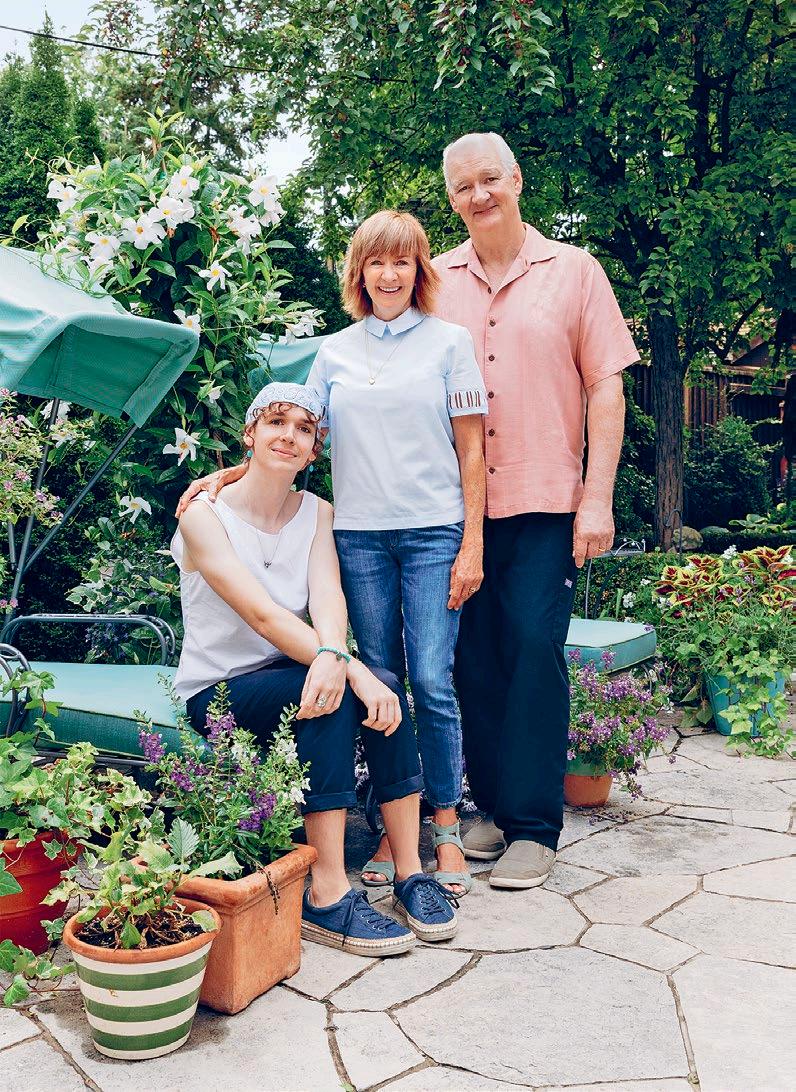 Author Debra McGrath at home with her husband, Colin Mochrie, and their daughter, Kinley
Author Debra McGrath at home with her husband, Colin Mochrie, and their daughter, Kinley
Iam a trans woman. I would like she/her pronouns and my name is Hannah.”
This is the sentence my son blurted out to me over the phone three years ago. Despite its bluntness, the statement wasn’t callous or even ill-timed. Truth be told, I had forced the declaration. My child had called with something important to say and wanted to talk to my husband, Colin, and me at the same time, but Colin was out of town. Given that I possess a not-insignificant panic strain in
After more back-and-forthing, out it came: “I am a trans woman. I would like she/her pronouns, and my name is Hannah.”
I paused to take in the situation— or at least lie to myself that I was taking it in. Then, relentlessly upbeat, I exclaimed: “I’m so happy for you, very happy. You know that your father and I will support you 100 per cent, and it’s wonderful and I’m not super surprised and you are such a wonderful person and we really don’t care what you do with your life as long as—”
OUR CHILD IS A WOMAN.
AS MUCH AS I THOUGHT I WAS PREPARED FOR THAT, I GUESS I WASN’T
my genetic makeup, I found myself, well, panicking. Was my child injured? Ill? Dying?
I conjured the thin thread of authority I had over my then 25-year-old and said, “No, you have to tell me now!”
“I would rather wait,” was the meas ured response.
I could feel all the saliva
I possessed leaving my body for damper pastures. I couldn’t have this matter hanging, so I pushed and pleaded, cajoled and begged. It was a shameless display—clearly, I wasn’t above that.
Dear God, I had to find a way to shut up. I was exhausting myself.
I’m what I call an emotional first responder—when a loved one is sharing something difficult or complex, I put on my support cape and swoop in to distribute accolades and platitudes willy-nilly. Breathe , I urged myself. Breathe.
“So, um, why ‘Hannah’?” I heard myself ask.
There it was. Apparently my takeaway from this huge moment in my child’s life was a name. “Hannah” seemed to be my issue. Shallow waters run deep.
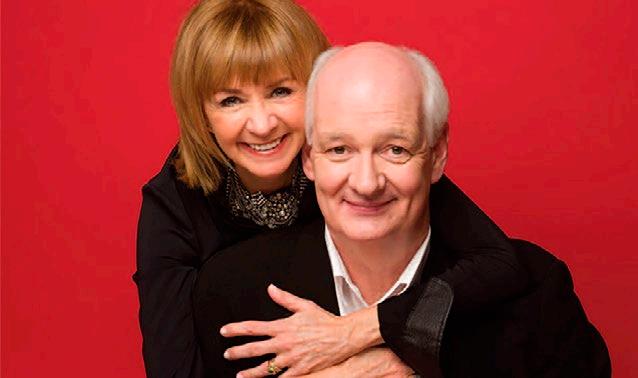
She responded to my question in a very calm manner.
“Mum, you know how much I loved Cheryl’s dog.”
“You are naming yourself after Hannah the dog? Really?”
“I thought the name was soft and pretty, and I needed my name to be soft and pretty. Does that make any sense?”
Of course it made sense. My heart ached with shame. I was officially a bad person.
Because it had been a few moments since I’d launched into a breakneck run-on sentence, I said, “Well, if you love the name Hannah, I love the name Hannah, and I am sure your father will love it, and I am so glad it makes you
feel beautiful, because you are beautiful, inside and out, and I support this choice wholeheartedly, honey. It’s your life and you are old enough to make your own choices and—”
At this point I was desperately hoping someone would hand me a pill.
Hannah stopped my runaway train of thought by cutting in: “Thanks, Mum. I love you so much and I knew you would support me. Why don’t I come over the day Dad gets home and we can have dinner and spend time talking?”
“Of course, yes, um, Hannah. We can do that. That would be really great. What a wonderful idea, um, Hannah.”
Mercifully, she wrapped up the conversation with “great, love you, bye” and hung up before I could even respond.
I spent the next few hours pacing up and down the stairs of our home, our two cairn terriers at my heels. As I attempted to sort out why I was upset, the dogs kept their gaze trained on me: walk? Are we going for a walk? Walk?!
After really analysing my reaction and my feelings, it came down to one thing. I was fine with my child’s transition. I wasn’t invested in her
clinging to me like possessed dryer sheets. I had made peace with our child’s news and had no issues with the concept of her transition, but I was still mourning the loss of our son. I didn’t even get a chance to say goodbye.
She is a woman. As much as I thought I was prepared for that, I guess I wasn’t.
I had to remind myself that this shouldn’t have been a huge shock. A few years before our daughter came out to us as trans, she had broken up with her girlfriend of
COLIN AND I LISTENED AND LEARNED. WE SO WANTED TO RESPECT WHAT OUR DAUGHTER WAS GOING THROUGH
gender, just her humanity. But there was so much fear: fear for her safety, fear for how the world might treat her, fear for her heart.
The two following nights were fraught with nightmares. I dreamed our son was lost. Our son was dead. We never had a son. I gave birth, but when I looked for my son, they told me at the hospital that I was mistaken and had simply had my appendix removed. Our son had joined a tiny-house cult and was never heard from again.
Once I woke up, I was a zombie, the despair of those horrible dreams
four years. She told us she was bisexual and wanted to explore that. Then she began, as she put it, “experimenting with my femin ine side”. After almost a year of seeing her integrate more traditionally femin ine looks into her wardrobe, we became used to this new bi, fluid, femme, butch, male/female person. LGBTQ+ wasn’t allencompassing enough. It’s like she was rocking the whole alphabet with her identity.
And then she landed.
The day after Hannah’s call, her dad came home. He was fine—no
anxiety, no nightmares, just a loving parent in a relaxed state of acceptance. Showoff! As a result of my constant anxiety, I resembled an 80 year old with dirty hair who had lived hard. Having no control over much else, I opted to shower. An all-around good choice, I thought.
The following afternoon, we were in the kitchen making pasta primavera—our daughter’s favourite meal—as we waited for her to arrive. We were also spending the time diligently practising pronouns. I was busy “she”-ing and “her”ing it up with zeal, but every time I said “Hannah”, the name came out garbled, like I was drunk and wearing my night guard.
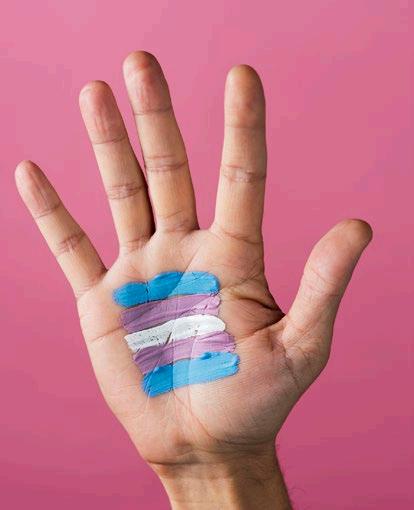
At some point, we heard a key turn in the front door, and in she walked. To my elation, no one was lost or missing. They were all here in the hall: the hes, the shes and the thems, in one beautiful package. No one had left us. The same human we first met 25 years earlier was standing right in front of us. We all started to cry. (Thank God it was all of us—I was tired of being the loopy one.)
WE MOVED INTO OUR SUNROOM, wine in hand, to chat. The three of us talked all the talks there were to talk, and Colin and I asked all the questions we could think of. Over the course of an afternoon that can best be described as an acronym-orama, we listened and learned. We so wanted to respect and understand what she was going through. We could see that she was exploring, too, taking time to listen to her heart and her mind.
At some point, the conversation moved into more familiar topics: her work and social life, Japanese films.

It was as if nothing had changed. And nothing had, really. It had always been the three of us, our tight little unit, and today was no different. We ate her favourite meal and then our lovely daughter went home to her flat.
Since that day, we have sometimes slipped up on pronouns, and she has always patiently, gently corrected us. We’ve gone out in public, and people have been mostly supportive, but there have been looks. Stares. Our daughter says she’s often fine with that—people are just trying to figure her out.
She’s definitely a more generous soul than me.
As time passed, I realised that I was somehow still stuck on the
name. “Hannah” was lovely, yes, but not nearly unique or powerful enough for my girl. But I knew I had to let it go.
Then, in a surprise turn of events, our daughter told us that many trans people come out using a name they don’t end up keeping. She said she had been thinking about it and she wanted a new name and would love for us to be part of that process. She asked us to pitch names from our Scottish and Irish backgrounds. I was elated and set to the task as soon as she was out of our sight. What a glorious privilege to get to help name her! I know it sounds silly, but it was like she was being born all over again. After copious research, Colin and I presented our daughter
with 40 names. She decided on Kinley, from the Irish side. Kin for short. It fits her. It belongs to her.
What is more difficult is figuring out how to move through the world such as it is. One day a year or so ago, Kinley and I were at a local fair. As we passed by a woman and her 20-something daughter, they shot a look of such hate and disgust that it left me breathless. The object of their ire was Kinley. The daughter, mouth agape, had exclaimed, “There’s a transvestite!” and the mother then wheeled around to spew, “Where is it?”
“It.”
She said “it’. I was gutted.
The younger woman circled my daughter, looking her up and down. We were stunned, frozen in place. As she walked away, I stumbled over to her on legs suddenly made of rubber. Circling her the same way she had circled Kinley, I looked her up and down, then moved close to her face, uttered “uh-huh” and stalked away.
In an attempt to recover, I said to Kinley, “This must make you so angry and upset.”
Her reply: “Mum, I can’t afford to be angry. I just get frightened.”
Frightened for just living her life. Frightened for existing.
I came home and, weeping, told Colin what had taken place. But after thinking about it, I realised that my reaction, although possibly
warranted, was also aggressive. That didn’t sit well with me. So I had cards made up. If things got ugly again, I would hand out a simple statement, embellished on one side with a lovely pink flower, that reads: “My daughter is a trans woman. She is a loving and kind human being. Please join me in supporting her and every person who is trying to live their authentic life. Peace and love.”
I remember the day the package arrived in the mail. Colin laughed as I opened the box of 250 cards. “Wow, you’re expecting trouble!” he told me. What can I say? There was a special if you ordered in bulk.
I am happy to say that I have not handed out a single card.
Instead, I get to focus on Kinley, my lovely, brave, poised, bright daughter. I have a daughter! There should be a newer, more powerful word for pride. As for our family, life as a trio continues as before, filled with old favourites (like watching movies) and new experiences (like buying bras).
A little while ago, Kinley and I were out shopping for clothes. As we exited our separate cubicles in the changing room, we realised, laughing, that we had tried on the exact same dress.
I ended up buying one dress for me and treating Kinley to hers. At least that way I know she won’t be raiding my cupboard—because that’s what daughters do. n
Since the start of the civil war in 2011, 5.6 million people have fled Syria to escape its bitter conflict. A fraction of those have built new lives in Britain. But getting to safety is just one of many challenges facing refugees settling in the UK—finding work isn’t easy, either. For these three resourceful people, setting up their own businesses in the food industry proved to be the best option, each one bringing something new to Britain. These are their remarkable stories



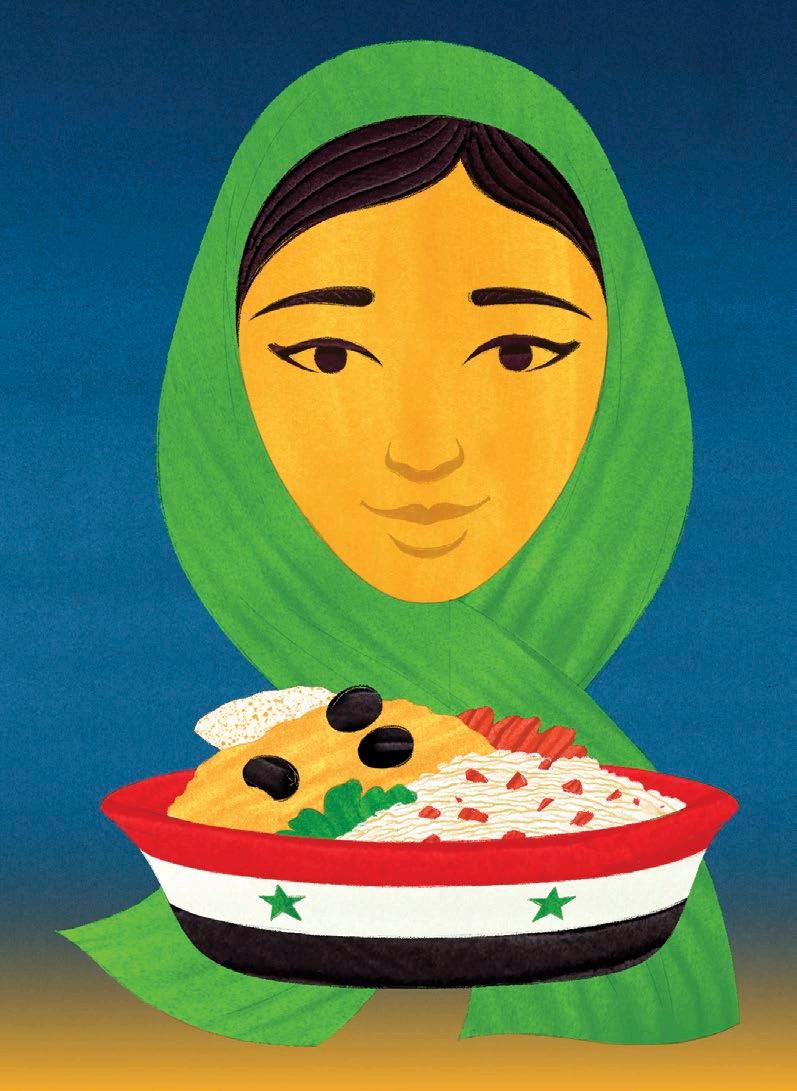
Since launching Yorkshire Dama Cheese, Razan Alsous has won 22 awards for the quality of her cheese. Any way you slice it, that’s impressive. Even more so when you consider this: Razan had never made cheese before starting her business in 2014.
In that short time, Razan can count a visit from Princess Anne, being interviewed by Cate Blanchett for the UNHCR, and an appearance on BBC’s Countryfile among the businesses’ many achievements. Though there’s been plenty of success, it has come at a tremendous cost.
Razan arrived in Huddersfield, West Yorkshire, in 2012, with her husband, Raghid, 55, and three young children. They had left almost everything in Syria, as the country plunged deeper into a vicious civil war. Despite having a degree in pharmacology, a lack of references and British work experience made finding a job difficult. For well over a year Razan searched, desperate to build a new life for her family, until one day, a tiny piece of her Syrian culture clicked into place, in Yorkshire. “We used to buy it from the supermarket, but we didn’t love
the taste or the texture because halloumi here uses much more powdered milk than fresh,” she says, recalling a trip to the supermarket to buy halloumi, a staple breakfast food in Syria.
“I noticed how wonderful the milk in Yorkshire is. For people living here, you might not find it unique, but for people from overseas, the taste is absolutely different to other milk,” Razan says. “All this information clicked in my head— why can’t I do this [make cheese] for a business using British milk?”
With a grant of £2,500 from the West Yorkshire Enterprise Agency, Razan was able to rent a small shop in Sowerby Bridge, Halifax, and buy the basic equipment she needed to get started. Raghid, with his engineering expertise and knowledge of the food industry, adapted the machinery so it would meet their needs. “We started making cheese with equipment that wasn’t made to make cheese,” she says.
Today, Razan sells her “squeaky cheese” (the name “halloumi” is trademarked as a designated Cypriot product) in shops all over Yorkshire, Scotland and the south of England, as well as

“I NOTICED HOW WONDERFUL THE MILK IN YORKSHIRE IS. FOR PEOPLE LIVING HERE, YOU MIGHT NOT FIND IT UNIQUE, BUT FOR PEOPLE FROM OVERSEAS, THE TASTE IS ABSOLUTELY DIFFERENT TO OTHER MILK”
online. Although the pandemic has hindered production, Yorkshire Dama Cheese is finding its feet again. Having been through so much already, Razan is used to working in a crisis.
“Life is always up and down.
Maybe because we have experienced a different pandemic—leaving our country, our home, leaving our history. We had to leave everything behind and come here. It helped us to understand life better and absorb problems,” says Razan.
Before COVID-19 ground the world to a shuddering halt, Mohammed “Mo” Rahimeh was cooking eggs. Lots of eggs. Sometimes, his brunch club “Mo’s Eggs” would serve as many as 150 people during its monthly Sunday sitting.
“Sometimes I’d make 600 eggs! It’s crazy,” he says.
Mo was settling into a new space, Benk + Bo, in London’s famous Spitalfields Market when the pandemic hit, forcing him to put his popular pop-up on hold. Like many, Mo has found lockdown tough. “I like to meet people face to face, so it’s been hard for me staying at home.”
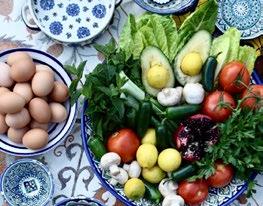
journey, Mo found himself in Calais’ infamous Jungle refugee camp. It was here, amid the makeshift shelters and sand dunes, that Mo would begin an unlikely path towards starting one of London’s hottest brunch clubs.
It all started as a gesture of thanks.
“There is something called the Jungle Box, where volunteers teach English.
I didn’t speak any English at all.
“WHEN I COOK THE EGGS, I COOK IT FOR MYSELF, AS IF IT WERE ME EATING IT. MAKE IT GOOD, MAKE IT DELICIOUS”
Other than his famous baked eggs, Mo’s ability to connect with people is at the heart of his remarkable success story.
In 2016, Mo fled his home in Damascus. The conflict in Syria had torn into its fifth year with little sign of abating; after a treacherous
I started to invite my English teachers to my shelter, cooking for them with what we had.”
During his year in the camp, Mo began volunteering around the Jungle, helping out where he could. As his English improved, he’d act as a translator between Arabic-speaking refugees and other volunteers. But it was in the kitchen where he really found his voice.
“At the end of the day, I’d be ‘Mr Chef’, cooking for refugees and

volunteers—we’d all enjoy food at the same table.” Despite having no professional cooking experience— back in Damascus, Mo was a tailor—his food was a hit. What he enjoyed most, though, was bringing people together.
As for his famous baked eggs, it was a case of combining his heritage with the ingredients available.
“I use recipes from my family, especially my mum. I try to keep my culture in the food, especially with the spices. We were lucky, we had cumin, pepper, and salt.”
Eventually, Mo made it to the UK in December 2017, but he would have to wait another year for his
refugee status to be granted. During this time, unable to work and encouraged by friends he’d met in Calais, he hatched a plan to start a Syrian brunch club, making use of his homeland’s signature flavours— fresh hummus, pomegranate salads, Syrian-style tea, and eggs.
Since his first pop up at Lost Boys Pizza, North London, last summer, Mo’s Eggs has snowballed into a brunch behemoth, with seats at one of his tables akin to culinary gold dust. So, what’s Mo’s secret? Well, it’s all in the eggs, of course.
“When I cook the eggs, I cook it for myself, as if it were me eating it. Make it good, make it delicious.”
When Ryad Alsous arrived in England, he knew one thing: he wanted to keep bees. The insects had been a major part of his life in Syria, and, fleeing his war-torn homeland, it was a precious certainty amid so much chaos.
As a lecturer at the University of Damascus, Ryad had built a respected reputation for his research on Syrian bees. With over 500 hives, he produced over ten tons of honey every year. Fleeing his country in 2013, he lost everything.
Yet even with all his knowledge and experience, Ryad didn’t know if his dream would be possible in the UK. “I found that there is a lot of rain and the temperature isn’t very high. All the time on the way back from the airport, I was thinking, How can I set up another project here? I thought it would be impossible because of the weather.”
The wet weather wasn’t Ryad’s only challenge. The language barrier and a vastly overqualified CV made it difficult to find work. Eventually, Ryad volunteered at the Huddersfield Beekeepers’ Association, but he was still without a colony of his own. It would take three years for Ryad to begin his British beekeeping adventure.
Finally, Facebook brought him
into contact with a woman in Manchester who was willing to donate an entire colony of rare British black bees.
“In one year, I was able to split the colony she gave me into seven. I realised that the beekeeping project could become very profitable and successful in the UK.”
Soon, Ryad found himself with 17 hives, but he wasn’t finished yet. His inner teacher was itching to get out. Through City of Sanctuary, a British refugee charity, Ryad began to run beekeeping workshops for refugees and job seekers. The Buzz Project was born.
Then, in 2017, a random encounter with the Huddersfield mayor would help take the project to the next level. On his advice, Ryad approached The Canal and River Trust, obtaining a patch of land on the banks of the Huddersfield Narrow Canal with space for ten hives. A grant from the Police Commissioner’s Fund followed, allowing Ryad to buy vital equipment and supplies.
Today, the Buzz Project houses 14 hives, where Ryad shares his expertise with 25 students—a relationship that’s starting to bear fruit. Last year, they produced half a ton of honey (around 1,000 jars). But
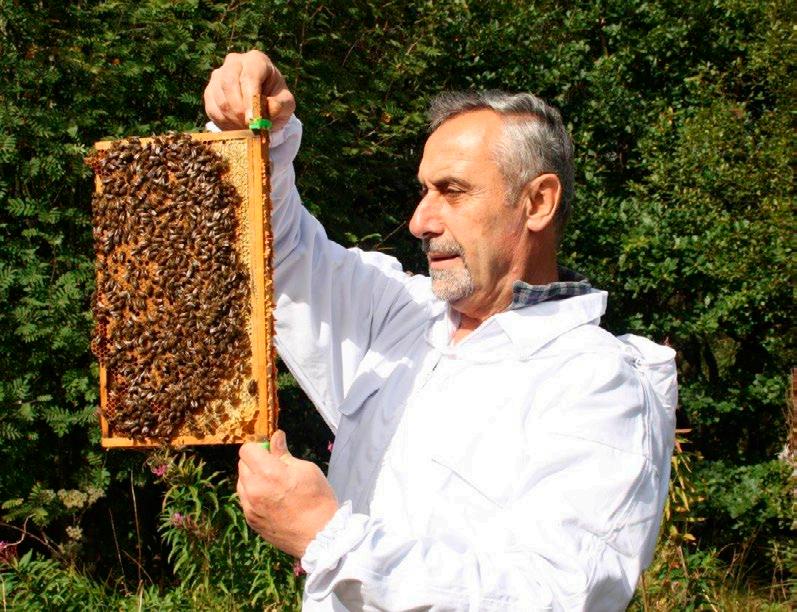
“I WAS THINKING, ‘HOW CAN I SET UP ANOTHER PROJECT HERE!’ I THOUGHT IT WOULD BE IMPOSSIBLE BECAUSE OF THE WEATHER”
for Ryad, the most important thing is bringing people together.
“We have local people, jobseekers and volunteers, in addition to refugees. All of them work together doing the same job. The exchange between the groups, the information and skills, helps them integrate very
well and improve their language skills,” he says.
Once it’s safe to do so, he’s hoping to increase the Buzz Project’s honey production and open a shop. “It will be like a co-op, selling their honey and products made from honey,” says Ryad. n


Colourful temples, such as this one in Jiufen, can be found all over Taiwan
With a toot of its horn and a metallic screech, the Alishan Forest Railway rumbles out of Chiayi, a midsize city in southwestern Taiwan. The humid jumble of roaring motorcycles and bubble tea shops makes way for betel nut plantations and clothes lines in small-town backyards that straddle railroad tracks first built for loggers.
The train, a popular attraction that brings travellers up and down the mountains, sputters through rice paddies and citrus orchards so close I can almost reach out and nab the fruits from my window. Bamboo and sugar palms tickle the sides of the train. As we coil higher toward the

peak, around Z-shaped bends and through mossy tunnels, the views fade behind a veil of cold fog held up by ancient red cypress trees whose cobra-size roots cover the ground like noodles in soup.
My journey to the mountain resort of Alishan is a two-hour slideshow of kaleidoscopic green that sums up the diversity of Taiwan. This is a land where a traveller can go from tropical coast, through soaring mountains, to dense woodlands in under two hours—part of the appeal of exploring this eggplant-shaped nation roughly half the size of Ireland.
Alishan is one of my favourite stops on a road trip through the country, beginning in the capital, Taipei, in the north; continuing through some of the nine national parks full of hot springs, waterfalls, gorges, and evergreen tropical rain forest; over cloud-shrouded mountaintops; and on to the crystalline beaches of the far south.
Taiwan has been close to my heart since I first came, in 2012, wide-eyed on an eight-month gap-year jaunt around Asia. My guide was a girl named Etty, who I’d first contacted via the "Couchsurfing" app, and met for coffee in Bangkok to share travel tips (she was planning to visit my home country of the Netherlands). We happened to be in Taiwan at the same time, and I ended up meeting her parents in the country’s second city of Taichung—a town of
Tea plantations colour the Alishan countryside an intense green

skyscrapers and steaming, neonglowing night markets.
We were soon planning trips through Japan, Cambodia, and Sri Lanka, while it dawned on us that this was more than a holiday fling. We moved back to Bangkok and are now married with a one-year-old who has a Taiwanese middle name and a Dutch last name.
Visiting Taichung two or three times a year, I’ve come to see it through my wife’s eyes—as a home of sorts, a place for crammed dinner tables and toasts of kaoliang sorghum liquor to Popo, Etty’s late grandmother. Over Auntie Chao’s beef noodle soup, my father-in-law sometimes gets misty-eyed talking about the sunrise over Yushan, Taiwan’s highest peak, or the volcanic landscapes, cherry
blossoms, and bubbling waterfalls of the Yangmingshan National Park, on Taipei’s northern fringe.
A retired forestry official, my father-in-law helped found some of the country’s national parks and was posted to many of its wilder corners. He’ll remind us that 60 per cent of the country is covered in forest, and that it was for good reason that Portuguese sailors christened it Ilha Formosa, or "Beautiful Island", when they washed up here in the 16th century.
Taiwan was partly ruled by the Dutch and the Spanish in the 17th century, then held completely by the mainland Chinese until it was invaded by the Japanese in 1895. The new rulers built railroads, tunnels, and factories, turning Taiwan into a supplier for Japan’s booming industry until they were ousted after the
Second World War. Chiang Kai-shek, the Chinese Nationalist leader who fled the newly Communist mainland in 1949 to set up a stronghold in Taiwan, envisioned a Confucian society with respect for the past, along with a Western-friendly form of capitalism. Even as the country emerged as one of the four Asian Tigers, the genteel culture he nurtured has endured.
I feel the Japanese influence at Jiufen, one of my first stops, a seaside town in the lush mountains east of Taipei. Its teahouses on the hillsides and lantern-lined alleyways were mostly built by Japanese goldseekers in the late 19th century.

Today, the majority of visitors are still Japanese, though they largely come because Jiufen is said to be one of the inspirations for the setting of the animated movie Spirited Away.
We hike upward through grassy plains to a stack of colossal boulders on top of Teapot Mountain as softspoken Taiwanese guide Steven Chang talks of mô-sîn-á—the folk creatures believed to cause hikers to lose their way. From the summit I see a lone octagonal pavilion on a distant jagged mountaintop. In the valley behind me are the crumbling remnants of a Japanese Shinto shrine; beyond, the deep-blue nothingness of the East China Sea.
Wherever you are in Taiwan, temples are never far. Their crowns jut from suburban neighbourhoods and far-flung forests, topped with multicoloured dragons, phoenixes, and intricate scenes dancing from one gabled roof to another. Every feather, every scaled claw, every whisker is painstakingly created from smashed-up plates and tiles, a traditional Chinese craft that has withered on the mainland in tandem with religion. In Taiwan, Taoism, Buddhism, Christianity, and curious folk customs have flourished together.
We drive to Shitoushan, 90 minutes southwest of Taipei, passing verdant rice paddies and one-street townships where women in tartan bucket hats hawk plump pomelos and football-size cabbages from the

backs of pickup trucks. Our home this night is the Taoist Quanhua Temple, a sprawling mess of staircases, pagodas, and ceramic cranes built into a sandstone cliff face. I step onto my balcony to find the sky a shade of gold, the air sweetly fragrant from smouldering incense sticks. The valley echoes with chirping crickets and the mumbling of prayer, interrupted only by the occasional clang of a gong. Somewhere in the distance, I hear a wail. Leaving the temple to trace its source, I discover a little shrine half-embedded in a cave. A woman clad in a pink tracksuit is crying in front of the altar. A short man with salt-and-pepper hair joins me and explains that the woman is hearing otherworldly voices. “It’s the language of gods,” he concludes, as the woman does ballerina-like jumps of ecstasy.
“She has the gift.”
That night I am in bed by eight,
lines of prayer still droning from monastery speakers.
South of Shitoushan, the Central Cross-Island Highway connects Taiwan’s populous west with the wild east, through the peaks and gorges of the Taroko National Park, eventually arriving at the Qingshui Cliff, 13 miles of forested bluffs that plunge almost vertically into the Pacific Ocean. We stop at the Tunnel of Nine Turns viewpoint, where Korean, Thai, and Japanese voices mingle with the hypnotic gurgle of waterfalls feeding into the gorge from thousands of feet above. Swallows sweep in and out of cliffs that are like layered cakes of swirling marble. Below me the Liwu River rages around mammoth boulders.
Deeper inland, it's just us and the road, silent black tunnels opening into muffled bamboo forests or

Sun Moon Lake in central Taiwan is the country's largest natural lake
curious villages smothered in moss. Mr Wang, our driver for this section of the trip, occasionally breaks the silence to talk of Formosan black bear encounters, boar-hunting trips, and ambushes by wild macaques.
One story is halted by the sound of a gunshot in the distance. “Mountain rats,” he mumbles, of the poachers who kill wild boar and muntjac, a type of deer. “But nothing compared to the head-hunting tribes who once roamed these forests.”
Beer cans, cigarettes, and areca nuts wrapped in betel leaves are laid on crumbling roadside walls, folksy cries for good fortune.
As we rise and the pressure increases on our eardrums, needles replace tropical foliage. Conifercovered peaks huddle like giants with hairy backs. The road finally reaches Sun Moon Lake. We pull into a nondescript restaurant to eat beef
noodles at circular Formica tabletops, tube lights reflecting in the soup’s oily film. From the kitchen comes the chack-a-chack of a ladle hitting a fiery wok; behind us, a lady sells “frog eggs drink”—kumquat lemonade laced with basil seeds. I spend the better part of the afternoon lolling around the lakeshore, watching bushy-tailed squirrels steal papaya from vendors, listening to a lone violin player scratching out Chinese folk tunes.
South of the lake we stop to visit one of the region’s tea plantations, which grows oolongs prized like Champagne. Between two of thousands of neat lines of shrubs, we meet a troupe of tea pluckers in traditional hats draped with colourful Hello Kitty-emblazoned cloths. A man in his fifties with a tar-black betel nut smile waves us closer, showing me a razor blade taped to his gloved index finger. “We harvest all our tea by hand,” he tells me. “None of that machine stuff. Only the freshest leaves, the highest quality.”
Heading south, a different Taiwan emerges, one I remember from my first journey. The dialects are trickier than the crisp Mandarin up north, the food sweeter. Everywhere seems to bathe in a permanent golden glow.
We stop at a giant fiberglass pineapple, manned by a chirpy woman in a frayed straw hat. “I’ve never seen foreigners stop here before,” she says as she hands me a slice of pineapple. I can barely finish one slice before another is in my hand; as we try to pull away, she rushes out with three bottles of pineapple juice. Anyone who has ever visited Taiwan, or met my motherin-law, knows that this is typical in a country where “Have you eaten yet?” is everyone’s first question.
The next morning we arrive in Dulan, a seaside town where windswept palms fill the land between the sea and mountains. At the WaGaLiGong hostel, where psychedelic murals cover the tiled façade, I meet co-owner Mark Jackson, a surfer from Durban, South Africa, who arrived 17 years ago. “When I first saw this place, the colours just hit me,” he says. “It’s kinda like a little Hawaii, with its own rhythm.” Work has begun on a resort in the nearby mountains. “It’s not going to stay like this forever,” Mark says, shrugging.
Nothing ever does. But, sitting on the black sand beach east of Dulan, watching the surfers paddle out to the roiling swells, I feel that happy sense of otherness I felt during my first trips here. Taiwan still feels different from the rest of Asia. It may have become a home of sorts, but it remains somewhere else entirely. n
When to visit: In times of unrestricted travel, the best time to visit Taiwan is between November and April when the weather is generally dry and warm. Summers are hot (30 degrees plus) and wet, and the typhoon season runs from June to October.
GettinG there: China Airlines, Taiwan’s national carrier, flies non-stop to Taipei from London. Airlines, including KLM and EVA Air, fly to Taipei either non-stop or via connections in Asia.
LodGinG: Hoshinoya Guguan, surrounded by 10,000-foot-tall mountains in the hot-spring enclave of Guguan, has 50 rooms, each with its own mountain-fed onsen. Doubles from about £415, hoshinoya.com/guguan; Villa 32, at the Beitou hot springs in the lush Yangmingshan National Park, north of Taipei, offers the choice between marble-clad Western suites or Japanese tatami ones. Doubles from £600, villa32.com; The Lalu occupies Sun Moon Lake’s most striking vantage point, doubles from £565, thelalu.com.tw.
tours: Remote Lands runs seven-day trips around Taiwan, from £475 per person per day, based on double occupancy, remotelands.com; Intrepid Travel has tours starting from £195 per person per day, intrepidtravel.com.
As we’re getting closer to Christmas, our reader Waheeda Hales
reminisces about a romantic Christmas market cruise with her husband, Nick
When I stepped ashore at the first port of our cruise, I remarked that the week-long “Christmas Markets” cruise that we booked last minute should be renamed the “Fairytale Cruise.” Bremen, Germany is a shrine to the Grimm’s fairy tale, The Musicians of Bremen. A favourite of mine as a child, it tells of four overworked domestic animals who escape their owners and take their travelling band to Bremen. Eventually they capture some robbers and live in their house. My prerogative was to have my picture taken with the statue of the animals in their iconic pose.


Hamburg, the next stop, did not disappoint. We made a trip to the model railway museum which has displays of cities and sights from all over the world, in miniature. The market was superb and I was able to find Christmas cookies that supplemented the superb fare that we were served on the ship!

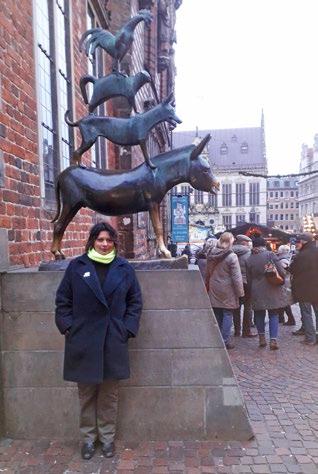
The last city on the list, Copenhagen, was the crowning jewel in our visit. It was also part of the motivation for the trip in the first place. My husband was eager to revisit the town where he lived for 15 months in the 1970s. The fairy tale theme continued as I made a customary trip to see the [statue of the] Little Mermaid. This involved scrambling over slippery rocks on a cold December day and being waylaid by another family who wanted me to take a picture of them. I was pleased to get my selfie in the end.
No trip to Copenhagen would be complete without a trip to the Tivoli Gardens. Again, an amusement park which gave inspiration to the great inventors of tales and stories, Hans Christian Andersen and Walt Disney to name but two. Nick and I spent a romantic evening there, not going on many rides but revelling in the gardens, lights and general spectacle.
The next thing we knew, it was time to set sail for the UK. We brought home a few Christmas gifts for family and friends that we found in the markets and shops in the various places that we visited. Much more importantly, we took back many great memories of our maiden cruise to last for years to come! n
Tell us about your favourite holiday (send a photo too) and if we print it, we’ll pay £50. Email excerpts@readersdigest.co.uk
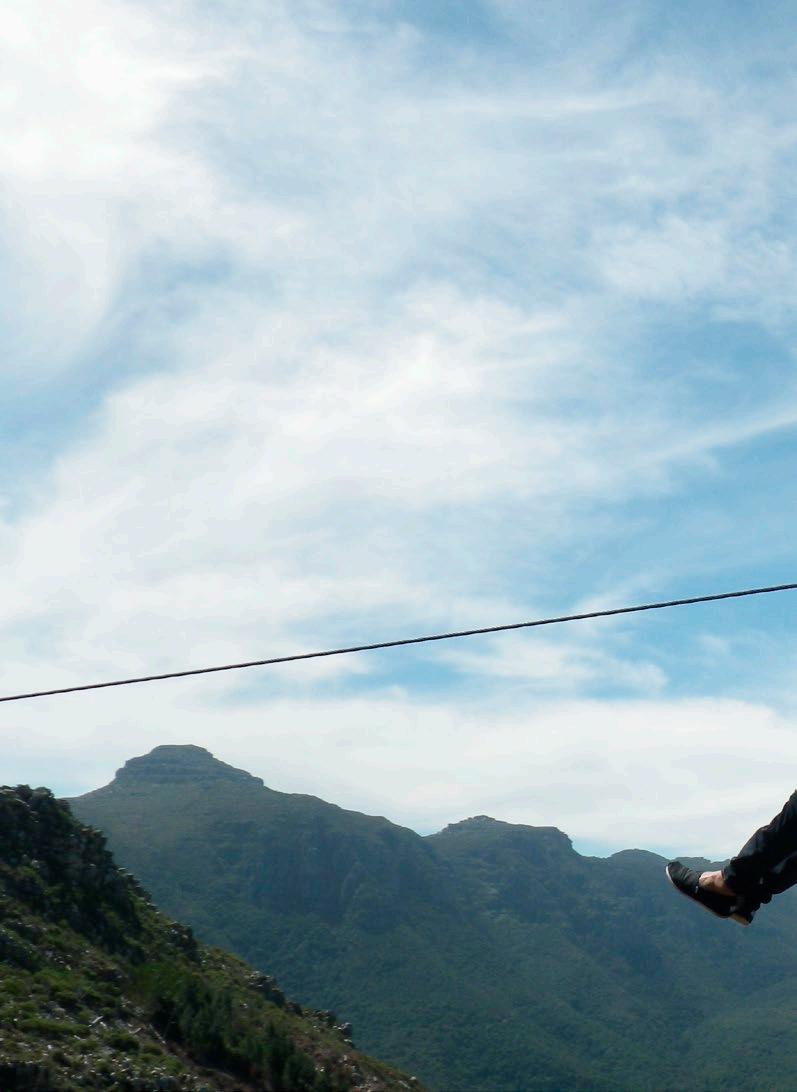
Lots of tourists make for Constantia, and quite rightly. Not only is the southern Cape Town suburb famed for longstanding vineyards—with an eight-stop wine route available—and their fine-dining but its valley borders botanical garden
Kirstenbosch, beach-lined area Hout Bay, the sea-hugging Chapman’s Peak scenic drive and world-famous Table Mountain National Park.
Closest to the latter, however, awaits an attraction about which few of those visitors, and indeed locals, know. As well as the gardens, restaurant and quirky Tasting Truck at Silvermist Organic Wine Estate, which borders the national park near low pass Constantia Nek, there’s a zipline route affording wondrous views.
Taking full advantage of the elevation provided by Silvermist’s steep mountain slopes, the route slowly descends from
platform to platform via 12 rides. The longest cable pushes 500m in length while some are 155m high; speeds are fast, yet not scarily so. Guides accompany you throughout following a safety briefing.
You’ll have vistas of Silvermist’s 120-acre estate, which is dominated by colourful fynbos vegetation, including spiky silver trees and cheerful daisies in many different colours. Below your dangling feet will be canopies and more open, scree-lined areas. Peaks loom in the distance, and you can look for Cape

Town landmarks amid the highest rides.
No experience or fitness is required, although there is some walking on uneven ground required to reach the platforms. Guests are driven up most of the mountain in a 4x4 car. The experience lasts around two hours and costs R600 (about £30) per person. n

think it’s great to get proactive and find ways to save money.
Cutting back, switching bills and shopping around will all mean you have more money in your bank account.
But there’s a good chance even the savviest among you are missing out on free cash. From unclaimed benefits to tax breaks, and from overpaid bills to forgotten accounts, here are the top places to look.

Andy Webb is a personal finance journalist and runs the award-winning money blog, Be Clever With Your Cash
This is any easy win—if you’re eligible. If you’re married or in a civil partnership then you might be able to get up to £250 back in tax this year, thanks to the Marriage Allowance.
As long as one of you is a basic rate taxpayer (so earning between £12,500 and £50,000 a year—the figures are slightly different in Scotland), and the other is a nontaxpayer (earning less than £12,500) you can put in a claim.
Essentially you’re moving 10% of the tax-free allowance from the lower earner to the other. For the 2020/21 tax year, that means £1,250 of the allowance is transferred to the higher earner. They’ll now not pay tax on
this amount. Of course, that means the lower earner has a reduced allowance of £11,250. So if they earn more than this they’ll now be subject to 20% tax on that extra. That’s why the saving is up to £250 as some could be lost the other way.
Even so, this could be a big payday for you as you can backdate your claim by four extra years—so to April 2016. The income levels in 2019/20 were the same as this year, but they were lower in the three previous years, so double-check you weren’t earning too much.
And if you can get all five years you’ll be entitled to up to £1,188. Though the current year is deducted from income, any payments for previous years will be received as a cheque.
Once you’ve applied you’ll keep earning it, though you do need to say if your circumstances change.
It’s also possible to apply retrospectively if you are widowed but your spouse was alive in any of those years—as long as you both met the eligibility criteria.
It’s simple to apply, just go to the HMRC website or you can call 0300 200 3300. All you’ll need are both your National Insurance numbers.
If one of you happens to have been born before April 6, 1935 then you’ll be eligible instead for the Married Couples Allowance which reduces the tax you pay by up to £907.50 a year.
Over the years it’s possible you’ve forgotten about an account or two that could still hold some of your money! The free website mylostaccount.org.uk will help you find what’s there—including Premium Bonds where you might even have an unclaimed prize.
If you’re still working then make sure you’re getting the maximum contribution from your employer. Often they’ll match what you pay in up to a certain level, so increase your payments if you’re missing out on their top-up.
And if you’re a high earner (over £50,000 a year) then you’re only automatically getting 20% tax relief on pension contributions. You need to manually claim the additional 20% via a self-assessment tax return.
Plus, don’t forget to track down any old workplace pensions. The

Association of British Insurers estimates there could be as many as 1.6 million pots lost due to moving house alone.
The Pension Tracing Service (gov. uk/find-pension-contact-details) will help you find out who ran the schemes so you can get in touch and find out.
For those already at State Pension age, it’s worth finding out if you’re entitled to Pension Credit. It’s a means-tested benefit that can not only top-up your income by thousands each year, but also save you money elsewhere.
For a start, anyone getting Pension Credit doesn’t have to pay the new TV Licence Fee charge for over 75s—an
annual cost of £157.70. You can also get Council Tax reduction, warm home discounts, free dental treatment and more.
How much you’ll get for the Pension Credit itself depends on your income, which includes pensions, benefits, savings and investments. But don’t let that put you off trying. According to the Department for Work & Pensions, more than one million eligible households haven’t claimed.
If you’re in a couple then both of you need to have already reached State Pension Age to get it—but you can start the process four months before that happens. To apply, call 0800 099 1234. You will need your National Insurance number and information about your income and savings.
You don’t need to have stopped working to claim support from the government.
Whatever your age or income there could be a benefit you’re missing out on. From a carer’s allowance to mortgage interest support, and maternity grants through to a funeral expenses payment, it’s always worth checking for you and your family.
There are a few good online calculators out there which will help you do this: I recommend Turn2Us. org.uk and EntitledTo.co.uk.
Some of the benefits will be means-tested, others will be tied to certain criteria.
Finally, it’s time to check you aren’t owed money on overpaid bills. Often when we pay a provider, say broadband, it’s done a month in advance by direct debit. That means if you’ve switched supplier there’s a chance the old company owes you!
Though these refunds should be automated, it’s worth checking to see if any have still got hold of your cash.
Meanwhile monthly energy payments are usually estimated based on a year’s use.
If your actual use has been a lot less, a mild winter perhaps, then it could be that your account is massively in credit. Get in touch with them and ask them to pay it back to you. n
Learn the stories behind some of these strangely named flowers...
Mirabilis jalapa or “the four o’clock flower” is so named because it opens in the late afternoon or at dusk (namely between four and eight o’clock).
The dandelion is also called “piss-in-bed” on account of its diuretic effects when eaten.
Scutellaria lateriflora or “mad dog skullcap” is so called because it was formerly used as an antispasmodic.
Agrostemma githago is a plant of cultivated cornfields and, hence, is referred to as “corncockle”.

Growing up living “the good life” on a farm in Northumberland, homecooked food was always a big part of family life. Our household was busy, so convenience was key but my parents always made sure we had wholesome and nutritious meals, and chicken was always a winner for me.
When I cook my chicken tray bake, the aromas fill the kitchen and it’s like I’m back at home 30 years ago. Having a daughter of my own now, I love that she’ll share those memories with me too, reminded of home by the smells that come from the kitchen.
Ingredients: Serves 4
Prep time: 20 minutes
Cook time: 45 minutes
• 1 whole medium chicken
• 3 sweet potatoes peeled and diced into 4cm cubes
• 4 sticks celery cut into 4cm pieces
• 2 medium tomatoes roughly sliced
• 1 large thumb of ginger peeled and shredded
• 3 cloves of garlic crushed
• 2 red onions roughly sliced
• Half a sweetheart cabbage shredded
• 3tbsp light soy sauce
• 1tsp cumin seeds
• 1tsp sesame seeds
• 1tbsp sesame oil
• 1tbsp vegetable oil
• Coriander leaves to finish
• Sea salt and black pepper to season
1. First rub a small amount of oil, salt and pepper all over the bird to increase the chances of getting some crispy skin, and ensure every part is seasoned and tasty. Put it into a roasting dish that allows a good 8cm space around the outside of the bird for your veggies.
2. In a bowl, combine the sweet potato, celery, ginger, garlic, red onions, tomatoes, cumin seeds, 2tbsp light soy sauce, salt, pepper and half a tablespoon of oil. Mix it well and scatter around the bird.
3. Place into a preheated oven at 170°C for 25 minutes. Take out, give the veggies a stir and put back into the oven until your chicken is cooked. The best way to know for sure that the bird is cooked is to use a temperature probe. For chicken you want it to read 70°C in the legs and the breast.
4. At this point, toss your shredded cabbage, sesame oil, 1tbsp soy sauce and sesame seeds in a bowl. Scatter this all around the chicken on top of the vegetables and put back into the oven at 200°C for 5 minutes.

Take it out the oven and allow to rest for 5-10 mins before arranging your veggies and carving the chicken. Then enjoy! n
Leon has recently launched a video series on Instagram called @_leon_eats, where he chats all things foodie with special guests including Liam Charles

As the weeks get longer and colder, there comes a craving for hearty, satisfying family dinners at home. If you’re looking around for some new winter recipe ideas, this traditional Polish “hunter’s stew” is bound to fill your kitchen with homely steam and deliciously savoury aroma of sauerkraut. And the best part?
Just like curry, it gets even better the next day, so you have a tasty lunch sorted.
1 Boil and pour hot water over the dried mushrooms and submerge them for 20-40 minutes, or until soft. Grind the black peppercorns. Cut the pork shoulder into large chunks, about 2 inches. Cut the sausages into similar-sized chunks. Drain the sauerkraut and set aside. Clean off any dirt from the mushrooms and cut them into large pieces.
2 Heat a large pot over medium heat. Add the pork shoulder and sausage; stir until the pork has rendered its fat and sausage is lightly browned. Set aside.
3 Put the onion and fresh cabbage into the pot and sauté for a few minutes, stirring often, until the cabbage is soft. Sprinkle a little salt over them. The vegetables will give off plenty of water, and when they do, use a wooden spoon to scrape any browned bits off the bottom of the pot. Add the tomato paste. Once the pot is clean and the cabbage and onions soft, remove from the pot and set aside with the pork shoulder and sausage.
4 Add the mushrooms and cook until they release their water then sprinkle a little salt on top. When the water is nearly all gone, add the pork shoulder, sausage, the cabbage-and-onion mixture, and then everything else. Stir well to combine. Bring everything to a simmer, cover the pot and cook gently for at least 2 hours.
6 Bigos is better the longer it cooks, but you can eat it once the pork falls apart. Check at 2 hours, and then every 30 minutes after that. When the pork is tender, fish it out and pull off the meat and fat from the bones. Discard the bones and the fat, then chop the meat roughly and return to the pot.

Serves: 6
Preparation time: 40 mins
Cooking time: 3 hours
Ingredients:
• 1 ounce dried wild mushrooms
• 2tbsp vegetable oil
• 900g pork shoulder
• 1 large onion, chopped
• 1 head cabbage, chopped
• 1 1/2 pounds mixed fresh mushrooms
• 600g pounds kielbasa or other smoked sausage
• 700g jar of fresh sauerkraut
• 1tbsp black peppercorns
• 1tbsp caraway seeds
• 2tbsp dried marjoram
• 2tbsp tomato paste
Upcycle pre-loved pieces with this simple DIY technique to give tables, chairs or storage cabinets a stylish mini makeover
1
Begin by removing any handles or hardware from your chosen piece of furniture and then wiping it down with a damp cloth to remove any dust and grime. Quickly wipe dry afterwards to avoid damaging the wood. Bear in mind that this distressing technique works best on solid wooden items and won’t be effective on wood veneer or plastic.
2
Using a fine-grade sandpaper, lightly sand over the surface of the wood to give it a good grip for painting. If you’re trying to remove existing paint or varnish, you may find you need a tougher paper for the job in order to effectively wear away these layers. Wipe down the surface after sanding to get rid of any leftover dust.

Homes and gardens writer and stylist
Cassie Pryce specialises in interior trends and discovering new season shopping
3 When it comes to achieving that shabby vintage finish, most people aim to reveal the wood grain of the furniture after it has been distressed. Apply one or two coats of your chosen paint colour to the surface and wait for it to dry completely.
4 Take your sandpaper—or wire wool if you prefer—and start to rub away areas of paint to expose the wood beneath. Focus on the edges and raised parts of the furniture in particular, as this is where the paint would be naturally worn. Use varying amounts of pressure with your sandpaper to achieve a rustic and non-uniform appearance.
5 Once you’re happy with the distressed finish of your piece, seal your handiwork with a good quality matt varnish or sealant to protect it from wear and tear. Finally reattach the handles and hardware. n
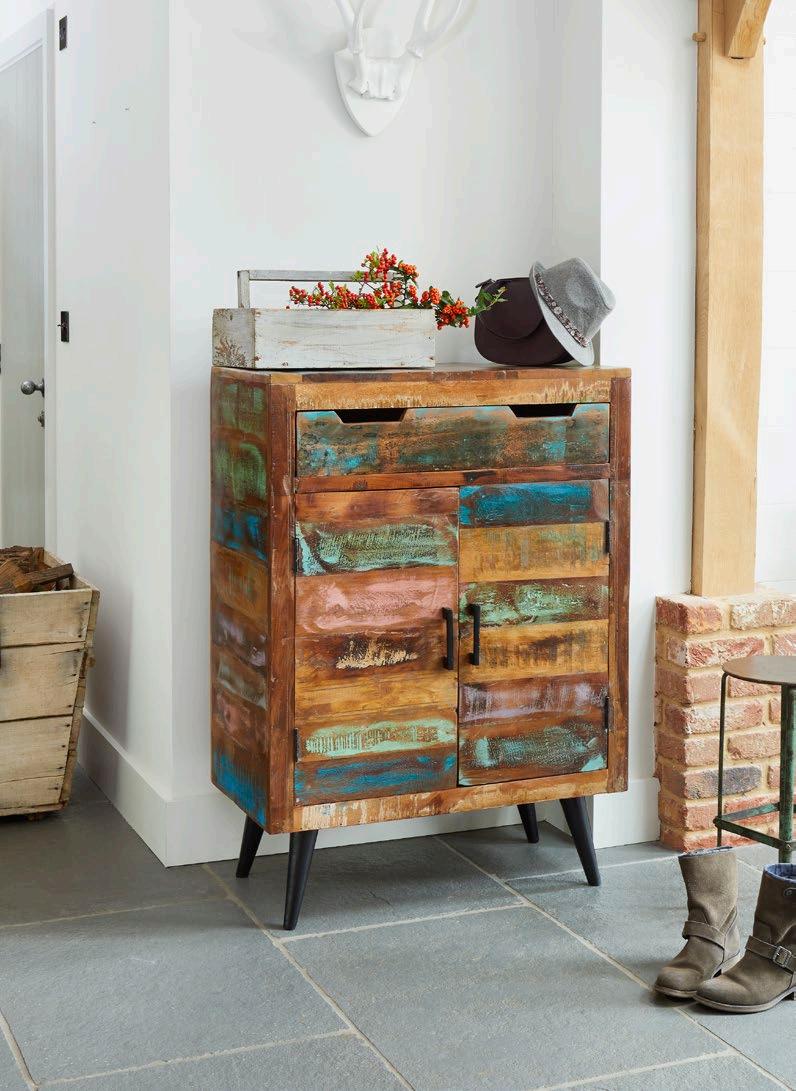
Our throwaway culture is killing the planet faster than we can save it
If there was ever an example of capitalism’s burden on the planet, fast fashion is it. The fashion industry alone is responsible for 20 per cent of global wastewater and emits ten per cent of our total emissions—that’s almost 2 billion tons of CO2 per year. To put this into perspective, one pair of jeans will cost the earth 3,781 litres of water and 20kg of CO2, approximately equal to the greenhouse gas emissions from driving a car nearly 50 miles. And, considering that less than one per cent of cotton crops are organic and most require around 11 per cent of pesticides and 24 per cent of insecticides to grow 6 billion pairs of jeans each year, it’s safe to say we have a colossal problem on our hands.
Yet synthetic fibres aren’t a viable solution either. Wearing polyester clothes is effectively like flouncing around in the latest fossil fuels—one polyester top has a 5.5kg carbon footprint, compared to just 2.1kg for a cotton one. Unfortunately, the cycle of ecocide doesn’t end there. Through washing our clothes, 1.7 million tonnes of microfibres are deposited into the ocean every year and while such tiny fragments might not initially seem damaging, it’s a huge problem. First, marine animals ingest the microplastics, then in a process called
bioaccumulation, it works itself up through the food chain and it finally reaches the top—to find humans— where our health could be impacted by the toxins released.
A phenomenon named “The Clothing Deficit Myth” has disillusioned many of us into thinking that donating our old clothes to charity shops for those in need, rather than letting them end up in landfills, is a grand solution. However, while some of our clothes discover a life with a new owner or get downcycled into something else, the large majority of unwanted garments are sold off in their millions to developing countries. Often though, these countries’ secondhand shops discover the clothing is of low quality and subsequently no one buys it, so it ends up in a landfill anyway.
Ultimately, the solution comes down to buying less—much less—and far less often. Making sure you only buy from companies using sustainable materials is a good start but we need to quell our habit of buying for the sake of it. Buy quality, long-lasting clothes, buy used clothes, swap with your friends and repair what breaks, find creative ways to express yourself without hurting the planet. It can’t be that hard, our ancestors did it. n
by Jessica Lone SummersHow did you become an authority in conservation?

In 2013, the Rana Plaza building collapsed, killing 1,138 Bangladeshi people and injuring thousands. Most of these victims were young women, making clothes for the biggest fashion brands. Fashion Revolution was born as a movement to enable consumers around the world to stand up for a fair industry.
In recent years, we’ve embraced the environmental campaign. We recognise that fashion’s hand in the climate crisis, biodiversity loss and plastic pollution is inextricably linked with its impact on the people who make our clothes.
What does Fashion Revolution do to help our planet? Our #LovedClothesLast campaign asks people to value clothing longevity in a culture that encourages us to treat clothing disposably. We also launched #WhatsInMyClothes to enable people to challenge the industry about the materials we wear. We want brands to take responsibility for the resources they use and waste they create.
What changes need to happen to tackle fast fashion culture? Whatever someone’s price point, buying clothing with the intention to only wear it a few
times is unsustainable. We need a culture of clothing longevity, while demanding that the fashion industry produce better quality clothing, and support the customer journey beyond the point of sale. Brands can help this change by offering repair services, product take-back schemes, and designing products that can be easily disassembled at the end of their life.
What will happen in the future if we continue this pattern? The fashion industry is not on track to meet the 1.5 degree climate target set by the Paris Agreement. The industry also doesn’t take responsibility for the waste it creates. Research suggests that a truckload of clothing and textiles is landfilled or incinerated every single second. Fashion’s waste is increasingly burdening the global south as European countries continue to export secondhand clothing and textiles at levels far beyond sustainable. We must look at waste as a resource, or a building block from which we create new things. In many countries, we’ve already run out of space to store our trash, and the practice of modern colonialism that sees it shipped elsewhere is unacceptable. n Visit
Make a statement while staying safe
Since our lives and our fashion choices are still very much affected by the coronavirus pandemic, I thought I'd focus this month's column on the must-have accessory of 2020—the face mask. We're stuck with thes e for a while, so we might as well try to make them as positive an experience as possible.
As always I try to think of the environment first, so I don't use disposable masks, as they aren't biodegradable and can cause

Lisa Lennkh is a banker turned fashion writer, stylist and blogger. Her blog, The Sequinist, focuses on sparkle and statement style for midlife women

havoc for wildlife when discarded irresponsibly. Instead, I keep several washable ones on hand beside my keys, so that I remember to grab one if I'm leaving the house. Right now, I need mine so infrequently, and with so many days between wears, that I don't need to wash them very often.
Like every other accessory, your mask can either be purely utilitarian or decorative AND functional. Of course, I tend to go for the latter. I’ve decided to try and put a positive spin on masks and make them a little fun rather than resenting the fact that they are needed.
My favourite mask is a cheerful rainbow striped one from Kurt Geiger. It goes with everything I wear. It doesn't look as ominous and unfriendly as a black one, and


has more flair than a utilitarian blue surgical one. It has a flexible nose wire, a soft lining, and because it is the most comfortable of all of my masks, it has fast become my goto choice.
My other favourite mask is one that I purchased from the Somersetbased decor shop, Courthouse Interiors. It is an iconic surreal print of many tiny hands applying lipstick. I bought this one purely for the fun factor, but it actually has a silver antibacterial treatment, is waterproof, and comfortable to wear. I choose this one for the rare occasion that I go out in the evening, or when I want to inject a bit of whimsy into an otherwise dull outfit. Another excellent mask supplier is Boden. They create them from
their end of run fabrics, so it makes good use of surplus material that otherwise might be scrapped. They're cheerful and fun like all Boden prints, and I like that which ones you are sent is a surprise.
I like to support small businesses, so I have bought several fantastic masks from Etsy online too. There are charming prints to match whatever your interests are. I'm mad about foxes, so of course I have a fox print one. My son is dinosaur obsessed, so he has a dinosaur print mask. Etsy sells sequin ones, leopard print ones, Liberty print ones, William Morris ones… whatever your style, they've got you covered. And as for the foreseeable future, covered is what we’ll have to be, so we might as well have a little fun with it! n
What can a facial cleansing brush do that a normal beauty routine can’t?
Jenessa Williams finds out…
Made from shower-proof silicone, these electrical devices are a handheld, ready-to-go spa routine. Simply apply your favourite cleansing product and use the brush to work the product into the skin in much the same way that you would with your hands. Once you’re done, rinse, pat dry, and apply moisturiser and SPF as normal.
The basic idea of the cleansing brush is that it does the heavy lifting of cleansing in much the same way that an electric toothbrush trumps the efficiency of a manual. The silicon bristles are anti-microbial and easy to clean, reducing cross-contamination for sensitive skin. Oscillating at a high frequency, these devices are said to remove even the most deeply embedded dirt, gently massaging them to the surface through T-Sonic pulsations. Stimulating circulation, they can also help reduce the appearance of wrinkles and improve clarity.
Apart from looking stylish in your bathroom, these products really are quite revolutionary, with visible improvements in the spread of facial breakouts. Foreo’s Luna 3 leads the market, with up to 650 uses from a single charge. You will need a smartphone connection to set it up, but in a time where self-care and personal routine is paramount it’s a surprisingly novel process, tailoring the product to your own personal needs. n
Hero Products



1.
3.
1 Daylight Saving Time
It wasn't until the First World War that the world officially adopted daylight saving time. Why? To conserve resources such as fuel and extend the workday for the war effort.
2 Trench Coats
While Charles Macintosh invented weatherproof outerwear a century before the First World War, Burberry modernised the design to keep British officers warm and dry. Today, many trench coats come with flaps originally created for securing pistols, maps— even swords.
3 Blood Banks
Up until the First World War, transfusions were rare, and done by transferring blood directly from person to person. Then Oswald Robertson, a US Army Reserve, recognised the need to stockpile blood before casualties occurred.
4 Hollywood
With Europe in the line of fire, its film industry had to scale back. That opened the door for the Americans. Hollywood soon made fortunes producing wartime propaganda.
5 Wristwatches
Timepieces known as wristlets were sold in the 19th century, but weren’t popular until the war demonstrated their superiority to pocket watches in battle.

A heartfelt French chamber piece that explores the price of putting your happiness before others’
They say distance makes the heart grow fonder. For Madeleine and Nina, that distance is just some 12 feet—they’re neighbours, you see. The distance created by Madeleine’s oppressive family and fear of judgement, on the other hand, makes it feel like they’re thousands of miles apart.
These two retired women have been in love for decades but were forced to keep their relationship secret— Madeleine’s been unhappily married for years, quietly suffering under her volatile husband’s thumb for the sake of the family.
When he dies, it seems like the two can finally fulfil their dream: run off
together to Rome, the city where they met and fell in love 20 years ago. But first, Madeleine needs to tell her children. As you’d expect, things don’t exactly go to plan and a tragic incident changes the couple’s lives forever.
The cleverness of this film’s premise lies in its simplicity: it’s a tender, beautifully told love story that’s heartbreaking yet also incredibly uplifting. On one hand, we witness the anguish that comes with the fear of living your own truth, reflected in Madeleine’s distraught eyes when she sits down at the dinner table with her kids. On the other, we witness Nina’s warrior-like determination to be with the person she loves, often disregarding common sense or even the law.
It’s a sumptuous, consuming story of a closely guarded secret that you’ll feel privileged to be let in on.
The topic of love and devotion isn’t exactly Michael Haneke’s usual fare. The director is known for his bleak, often cynical view of the world and a penchant for bringing the ugliest traits of humanity to the surface. Amour, then, was quite a U-turn for him. In it, Haneke introduces us to an older couple, Anne and Georges, who lead a cultivated, quiet life in France, until one day, Anne has a stroke. The consequences grow from severe to tragic, as Georges attempts to care for his wife while she quickly disintegrates in front of his very eyes. There are many reasons to watch this film: it won the Best Foreign Language Film Oscar in 2012 as well
as the Palme d’Or at Cannes. It also boasts a stellar cast which includes some of French cinema’s most distinguished names: Emmanuelle Riva, Jean-Louis Trintignant, Isabelle Huppert—it doesn’t get any better than this. But most of all, you should watch it for a moving, uncompromising portrayal of true love, empathy and stoic devotion. Haneke tackles the subject of ageing and death with grace and elegance, never looking away from the pain, but staring it directly in the eye. It’s by no means an easy watch, but it is essential viewing for one’s emotional education.
by Eva Mackevic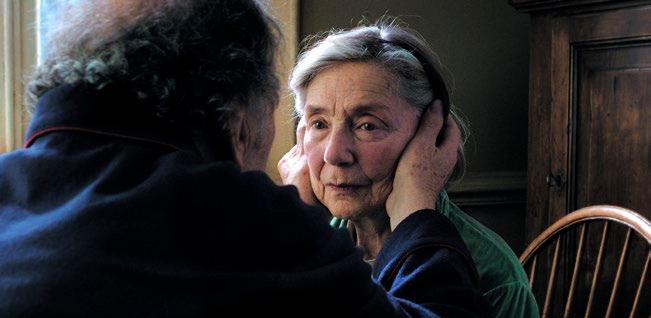
With a Presidential election looming, which shows could be said to best represent America’s recent political turbulence? One leftfield candidate would be BrainDead (Prime Video), a hybrid original—part West Wing-like procedural, part creature feature—in which Washington is infested by extra-terrestrial brainbugs, forcing senators on all sides to adopt increasingly extreme positions.
Smart and funny about the death of consensus, it ran but one season: at risk of lapsing into conspiracytheory hooey, maybe they cancelled it because it got too close to the truth.
BrainDead’s husband-and-wife showrunners Robert and Michelle King have had better luck with The Good Fight (Prime Video), spun off from their earlier The Good Wife. Following a moneyed WASP (Christine Baranski) as she joins a Black-owned law firm, the show uses the courtroom format to cross-examine
such talking points as police brutality and online hate speech. Moral without ever feeling issuey—and superbly played by elite character actors—it’s become a guide to what’s worth upholding, and what needs objecting to, as the world explodes around us.
Another valuable guide has been John Oliver, Birmingham-born host of satirical review Last Week Tonight (Sky Comedy). I say satirical, though in this pandemic year, the show has assumed a new, educative edge, deploying Oliver’s monologues to better inform viewers on such topics as the Black Lives Matter protests and calls to defund the police. A vital corrective to British satire’s current toothlessness, the show’s analysis and wit have only been sharpened by 2020’s myriad crises—we’ll need more of those qualities, whatever happens on November 3.
 by Mike McCahill
by Mike McCahill
ParksandRecreationS1-7(Prime Video)
The sunniness of this, the great Obamaera sitcom—set in a small-town parks department, with a Joe Biden cameo— makes it a perennial tonic: a show to turn to after switching off the news in disappointment or disgust.


There’s something profoundly timeless about the sound of the violin. With its wide range and colourful tones, it reflects the range of the human voice, expressing everything from deep sorrow to the most ecstatic moments of joy. Just listen to the heart rending, solemn passages of Fritz Kreisler’s Love’s Sorrow or the plucky and playful string shenanigans on Recitativo und ScherzoCaprice, Op. 6, and you’ll instantly recognise the feelings that fuelled the birth of these pieces—you’ve experienced them too. Siem guides us through these works with poise and grace, expressive phrasing and a deeply felt appreciation for the music he’s playing. Golan, vigorous and agile on the piano, follows him closely in a beautifully complex yet effortless interplay. It’s an exceptional recording that you’re bound to come back to regularly, and discover a bit of yourself in it each time.
by Eva MackevicThe design of the modern violin is over 500 years old
The Ashmolean Museum in England currently owns an estimated $20 million violin
The lyra evolved into the rebec and the medieval fiddle which eventually became the violin as we know it
The “violin” comes from the Latin word “vitula” which also means “female cow”
Mozart, known as a prominent pianist, actually started his musical training on the violin

This month’s literary picks centre on reflection and that difficult art of looking back, while moving forwards
Mr Wilder and Me
by Jonathan Coe (Viking, £16.99)Jonathan Coe’s beguiling new novel opens with the narrator Calista’s daughters leaving home and her work as a film composer drying up. But this feeling of no longer being needed is, she realises, one that she once saw in somebody else—when, aged 20, she became an awestruck assistant on Billy Wilder’s 1977 film Fedora.

case, on a career that began in Berlin, before the rise of Hitler meant that he and other Jewish filmmakers left Germany to transform American cinema.
And if you haven’t heard of Fedora, that’s rather the point. By that stage, Wilder’s glory days as a director— featuring such copper-bottomed classics as Sunset Boulevard and Some Like It Hot—were long behind him, as a new generation of directors took over Hollywood. So it is that Calista looks back on Wilder looking back—in his

James Walton is a book reviewer and broadcaster, and has written and presented 17 series of the BBC Radio 4 literary quiz
The Write Stuff
Coe doesn’t just keep these decades-spanning plotstrands moving along absorbingly; he also weaves them together into a moving reflection on time’s famously annoying habit of passing. Yet while the book certainly has a melancholy tinge, there’s consolation too in Wilder and Calista’s most treasured memories, and in the overall sense of lives well lived.
Three Women and a Boat
by Anne Youngson (Doubleday, £14.99)
Is it too late to change your life once you’ve reached late middle age? The career of Anne Youngson would suggest not. After working successfully in the motor industry until she was 56, Youngson took a creative writing course, studied for a PhD and, aged 70, published her highly successful first novel Meet Me at the Museum. Now, in her second, she explores the whole idea
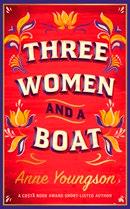
of uprooting an apparently settled existence and starting again. The novel’s acceptably contrived set-up means that Sally and Eve—two strangers in their fifties—find themselves piloting a canal barge from Uxbridge to Chester for repairs, while its owner, Anastasia, receives cancer treatment. Sally has just left her husband of 20-odd years, on the solid grounds that “everything about my life was wrong”. Eve has been made redundant from a high-powered job and beginning to wonder if committing everything to the company for so many years was a bad mistake. And from there, the novel is a bit like a bargejourney itself: gentle, charming, and— once the women become friends and discuss their futures—a chance to think about what really matters.
TheContenderby William J Mann (Harper £14.99). Brilliant and comprehensive (ie, quite long) biography of Marlon Brando, which does full justice to the extraordinary life of an extraordinary man.
TheCatchby Mick Herron (John Murray, £8.99). Anything in Herron’s brilliant spy series Slough Houseis never to be missed— including this superb novella (although anybody who hasn’t read him really should treat themselves to the whole series).
YoungElizabethby Graham Viney (Robinson, £10.99). The fascinating story of the 1947 royal tour of South Africa, where the future Queen turned 21 in a deeply divided country about to implement Apartheid.
Name the author
Can you guess the writer from these clues (the fewer you need the better)?
1. The title of a classic 1932 novel set in the year 2540 is taken from his work.
2. He was on the Bank of England £20 note from 1970-1993.
3. More films have been made of his works (by far) than those of any other writer.
Answer on p126
Olive,Againby Elizabeth Strout (Viking, £8.99). The winningly irascible heroine of Strout’s muchloved OliveKitteridgereturns in an equally good sequel.
ASongforYou:MyLifewith
WhitneyHoustonby Robyn Crawford (Dutton, £14.99).
Revealing and highly personal memoir from Houston’s long-term friend and confidante.
Comedian Katy Brand’s new book on the magnificent Mary Poppins has many life lessons to impart
Few films are so embedded in the minds of pretty much all of us as Mary Poppins. Just saying the title immediately conjures up a nanny floating to earth under an umbrella, spoonfuls of sugar helping medicine go down and dancing chimney sweeps with dodgy cockney accents (and to think there was once a time when the world had never heard the word “Supercalifragilisticexpialidocious”).

classic westerns, where a mysterious stranger rides into town, cleans it up and leaves again.
In Practically Perfect, the comedian and actor Katy Brand gives us the full story of how the film was made—not much to the liking of PL Travers, the author of the original book. She provides plenty of thoughtful analysis of the final result. “Is Mary Poppins a story about a nanny or a witch?” she asks at one point: a trickier question than it sounds. At another, she suggests an unexpected parallel with
But the book also makes a strong case that Mary Poppins has some important lessons to teach us— perhaps even more now than when it was released in 1964. Rather than vowing to get things done, for instance, Mary does them. She’s impressively free of any eagerness to please. She’d be entirely scornful of the current fashion for being “best friends” with your children rather than giving them the boundaries they
need (and secretly want). The book spares a chapter-length thought, too, for Mr Banks—father of Mary’s charges Jane and Michael—who comes to realise the price he’s paid for trying to live up to traditional expectations of manliness.
But back with Mary, here’s a passage in praise of her self-containment: a quality Brand considers badly underrated these days…
It sometimes feels like a lot of things that should be simple and fun have been turned into work by the creep of social media. For example, hobbies are now turned into commercial opportunities. It used to be that you could go to a local fair or fete and some woman would be there with her mate, selling jewellery they had made from one of those craft kits you can buy in the shops. Or perhaps a couple who make fudge at the weekends and sell it every now and again in little bags. It was for fun, it wasn’t meant to end up on Dragon’s Den.
Now there will be a board on every stall with all the social media info, plus a feedback form and an invitation to sign up for the monthly newsletter. I don’t want a monthly newsletter, I just want to buy some fudge to eat and then forget about it. It’s become work, that’s what I’m trying to say. Everything is work. It’s exhausting.
Mary Poppins goes to visit Uncle
Albert upon hearing that he has laughed himself high again (literally) and needs bringing down to earth. Of course, when she arrives with Jane and Michael, her natural sense of humour and mischief takes over and they all have such a good time they too float to the ceiling. But when it’s over she won’t hear another word about it. It’s done. It was great, but it’s over.
Sometimes I just want to see my friends and have a laugh without recording any of it for posterity. It seems almost shameful now to let a birthday gathering pass without a single photo or video taken and shared somewhere. It’s as if you didn’t really care you were there if you don’t record it.
Sharing everything has become the new normal—many of us shared pictures of our children on social media almost without thinking, but how many of us (myself included) are having second thoughts? We were so excited with all our new technology, and our new babies, that we forgot all about the sweet concept
Practically Perfect: Life Lessons from Mary Poppins by Katy Brand is published by HQ at £12.99

of privacy, not just for ourselves but for toddlers who can’t give their consent before video footage of them covered in their own poo, or eating a daffodil, or licking the cat, is halfway round the world. Some of the most viewed YouTube videos in the world, watched by tens of millions of strangers, feature children who can’t even talk.
I shudder at the thought of explaining Instagram to Mary Poppins. Can you imagine it? This is a woman who threatens to call a policeman on a child simply because he wanted to talk about their exciting day in the privacy of the nursery. The idea of Poppins sharing #soblessed pictures of them all having a picnic in matching bright white linen, applying sunlight filters, photoshopping her thighs and tagging #Bert #London #JollyHoliday is too much. The shame of the neediness would kill her first.’’
TheTwitsby Roald Dahl. I remember responding by turns with laughter and horror to this, as to all Dahl’s books. TheTwitshas particularly stayed with me, I think, because it has life lessons about happiness and generosity.
FirstTermatMaloryTowersby Enid Blyton. I saved up my pocket money for this, and the subsequent MaloryTowersbooks. I really bought into Darrell Rivers and being a “good egg” and never making a fuss. Plus the midnight feasts sounded so thrilling!
And the name of the author is…
William Shakespeare who, amazingly, we’ve never had before in seven years of this quiz. The 1932 classic is Aldous Huxley’s Brave NewWorld, whose title is from TheTempest(Shakespeare was the first person other than the Queen to appear on a Bank of England note).

MulgaBill’sBicycleby Banjo Paterson. My grandmother Violet loved all things Australian, and would read me books she bought on her trips there. This poem was a favourite, about a man whose pride comes quite literally before a fall.
TheNancyDrewFilesby Carolyn Keene. This glamorous, very 1980s update of the original Nancy Drew stories caught my interest. I loved any stories where the main female character solved mysteries or went on adventures.
William Boyd is a Scottish author and screenwriter. His new book, Trio, is published by Viking (£18.99)

I was born and grew up in West Africa in the then British colony of the Gold Coast, as it was known. It became Ghana on independence in 1957. My family lived in Ghana for a dozen years then we moved to Nigeria. So West Africa was my home. The extraordinary life I lived there seemed entirely ordinary to me. And it was in Nigeria that I read TheHeartoftheMatter,set in Sierra Leone, another ex-British West African colony. I was too young to fully understand Greene’s novel when I first came across it but it was the first time that I had read a serious work of fiction set in a context and a landscape that was utterly familiar to me. I suddenly saw how the details of your everyday life could be transformed—into art.

I read Couples when I was 19 or 20 in a kind of frenzy. It’s not regarded as John Updike’s best novel—its relentless sexual explicitness made it controversial—but for me it was a revelation. Here I was leaving my teens, adult life beckoning. But I couldn’t see myself as an adult. Updike’s novel solved all that . Even though it was set in New England among the privileged Waspy bourgeoisie, it stripped veils from my eyes. Here was the adult life unexpurgated, honest, clear-eyed. At the time I thought it was tremendously sophisticated and it made me look again at the adults I knew—my family, their friends, my university teachers.
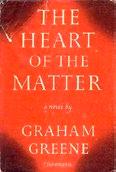

There were various reasons why I started reading Spark’s novels. I was beguiled by the 1969 film of ThePrimeofMissJeanBrodie and that led me to the book. Then I began to read everything Muriel Spark had written. She was a Scot, like I am, and I felt that vague nationalistic empathy. But what she taught me is how to create a tone of voice—Spark’s tone of voice is unmistakeable, her trademark—and how economy of expression, the right words in the right order, can create worlds, impressions, nuances and evocative understandings that no amount of verbosity can replicate.
Often in life there are times when we know what we should do, but due to a fatal combination of inconvenience and inertia, we don’t. We know that we should eat in moderation… but what harm is one extra slice of cake? We know we should figure out why the “check oil” light on the dashboard is ominously blinking… But it’s probably nothing, right? And we know that we should install the software updates that our phones keep nagging us about… but I’m in the middle of something, I’m trying to check Facebook… I’ll do it some other time.
Now, I don’t know anything about healthy eating or combustion engines, but I can tell you that this last one is important. If you take away one message from this month’s
column it is this: install the damn updates. Yes, it is annoying not being able to use our phones for a few minutes, but this is important. So to persuade you why you should, I’m going to try the “carrot” and “stick” approach.
First, let’s wield the stick. If you don’t keep your phone up to date, you’re putting your phone at risk from hackers.
Why? Because digital security is an arms race. Hackers will find security holes and new ways to break into our phones, so Apple and Google release new versions of the phones’ operating system (OS) software to fix the problem. Then hackers look through the new version of the software for new flaws they can use for attack. And so on forever.
This means that if you’ve not updated your phone to the latest version of the OS, your phone is conceivably vulnerable. So it is important to stay up to date to make
sure your phone is wearing the toughest digital armour.
So that’s the stick. But don’t worry, there’s a carrot for you too. The genuinely exciting part about software updates is that your phone will receive new features and functionality without you needing to buy a new handset! In fact, occasionally updates are so transformative that it can be like receiving an entirely new phone.
By the time you’re reading this, there should be new, recently released versions of both the iPhone operating system, iOS, and Android, the Google OS found on virtually every other smartphone, from Samsung to Motorola to OnePlus. And both have new features that, once you’ve updated, are going to make your life that little bit easier.
On iOS14, the iPhone is at long last going to receive a feature that Android users have been enjoying for over a decade: widgets on the homescreen. This means that instead of your phone simply displaying the icons of apps, you’ll be able to add interactive elements that can display information without needing to load up an app. For example, you’ll be able to add the weather or your calendar as a widget, so you’ll be able to see at a glance if it is about to rain or what your next appointment is, without having to tap into an app.
And if you own multiple Apple devices, such as an iPad or MacBook
in addition to an iPhone, or if you have a pair of Apple’s AirPod headphones, you’ll be able to seamlessly use them on all of your Apple devices. If you pause the music on your iPhone and hit play on a video on your iPad, thanks to iOS14 your AirPods will magically switch between devices.
And don’t worry, Android 11 has some clever new features arriving too. Most helpfully, there will be new controls to stop yourself being bombarded with constant notifications. You’ll be able to categorise notifications from different apps and people, so that you can always see, for example, messages from your family first, instead of random Facebook likes.
Android 11 is also adding a brilliant new feature that will help protect your privacy: from now on when an app asks if it can access your contacts, or your photos, or any other feature on your phone, you’ll be able to grant it a one-time permission. So while it might be useful to upload a photo, you’re not then granting that company the rights in perpetuity to rifle through your phone.
So, ultimately, my point is this: keeping your phone up to date is a win-win. Not only will you keep it safe, but you might also have a better phone afterwards. So I’ve heard enough excuses. Tap on settings app now, and finally install those updates! n
Win £30 for your true, funny stories!
Go to readersdigest.co.uk/contact-us or facebook.com/readersdigestuk
My grandparents were about to celebrate their 40th wedding anniversary when my grandad told Gran to name whatever she wanted, and he'd buy it for her, no matter how much it cost.
They'd had a little tiff that morning so she joked, “A divorce”.
“Honestly,” Grandad retorted, “I wasn't thinking of spending that much!”
SHANNON ROBERTS, Flintshire
I was selling some vintage toy Grenadier Guardsmen on the internet. They were quite collectable and fairly valuable.
In my hurry to get all the details down, I wrote on the description, "Left to me by my great Uncle Archibald, 4 inches high."
I got a reply straight away which read, "I want to buy them. How big are the soldiers?"
ANDREW BERRY, Lincolnshire
We were watching an old programme of Tarzan and Jane.
I could see that my son was puzzling over something.
I asked him what was wrong and he retorted, "Why doesn't Tarzan have a beard? I know they don't have razors in the jungle!"
ANNA HAMMETT, Cheshire
When I told my Sunday school class that a boy from the Netherlands would be joining us the following week, one little girl asked in great excitement if it would be Peter Pan himself.
MAGGIE COBBETT, Yorkshire
My grandmother is a woman of few words. She looked my grandfather up and down one morning and asked him,
"Did you shave today?"
"Of course I did!" he replied.
"Well next time stand a little closer to the razor." She retorted.
BETH WEBB, Denbighshire
I was talking about a forthcoming date and mentioned I was going to

have to put the clocks back. My son, overhearing, commented, “Can you remember where you bought them all from, Mummy?”
KAYLA MADDOCKS, HertfordshireMy dad is an identical twin. When my niece was a toddler and met my uncle she said to my sister, "Mummy, why does that man have the same head as grandad?"
LISA BEST, CheshireI don't have a gas cooker and I'm always hesitant when I'm trying to light my mum's. I spent ages pressing the ignition button to light the oven and had to admit defeat
and ask my mum to help. She spent a while doing exactly what I had before remembering the cooker has a gas hob but an electric oven!
ANN JOHNSON, CheshireMy two sons were sitting next to each other in church. Tomos was giggling and fidgeting a lot. Finally, his big brother Ben had enough.
"You're not allowed to be loud in church."
"Who's going to stop me?" Tomos answered cheekily.
Ben pointed to the back of the church and Tomos looked over.
"See those two men by the big door? They're hushers!"
JEENA SUMNER LondonMy husband realised our son had left his mobile at home, so he texted him to tell him. It was only when our son got home that evening and checked his phone messages that my husband realised how stupid he had been!
AMBER JACOBS, Cheshire






YES I want to subscribe to Reader’s Digest Magazine for just £3 for 3 issues (a saving of £8.37 on the shop price of £11.37 based on the cover price of £3.79 per issue). I understand that if I do not wish to continue receiving Reader’s Digest after my first 3 issues I can simply cancel my subscription by contacting customer services. If I do want to continue to subscribe after my first 3 issues I need do nothing and my subscription will automatically be renewed at the low rate of £7.50 for every 3 issues until I decide otherwise. Name: Address:

IT PAYS TO INCREASE YOUR
Our species sure accomplishes a lot. In fact, some psychologists suggest we should be called human doings rather than human beings. In celebration of our need to keep busy, here’s a quiz featuring words from our endlessly active language
BY ROB LUTES1. quash
A: suppress completely.
B: scrape clean.
C: mix together.
2. shear
A: cling to.
B: cut something off.
C: prolonged and highpitched scream.
3. abscond
A: scramble up a difficult incline.
B: slip and fall.
C: leave with something that doesn’t belong to you.
4. inculcate
A: ward off.
B: teach through frequent instruction.
C: breathe deeply.
5. lambaste
A: soak in brine.
B: criticise harshly.
C: cook at very low heat.
6. skulk
A: move secretively.
B: worry excessively.
C: excavate hurriedly.
7. lollygag
A: laugh out loud.
B: spend time idly.
C: eat sweets.
8. vitiate
A: impair the quality of.
B: talk negatively about.
C: embark on a new journey or activity.
9. nettle
A: cause physical harm.
B: prevent someone from escaping.
C: aggravate.
10. convoke
A: make more bearable or less severe.
B: quick and clever reply to an insult.
C: call a meeting.
11. impute
A: attribute blame.
B: gauge importance.
C: complain about.
12. blandish
A: bore.
B: coax with flattery.
C: conceal from view.
13. cadge
A: tease about a physical limitation.
B: make a defamatory statement.
C: receive something without paying for it.
14. avulse
A: tear away.
B: twist.
C: immerse in water.
15. yammer
A: snore deafeningly.
B: talk loudly and at length.
C: prop with planks.
1. quash—[A] suppress completely. A day after the president fled the country, the military sent in troops to quash the uprising.
2. shear—[B] cut something off. Each fall, Angus would shear every sheep in the flock and sell the wool to private traders.
3. abscond—[C] leave with something that doesn’t belong to you. Kelly hoped none of the tenants would abscond with the crystal light fixtures in her rental home.
4. inculcate—[B] teach through frequent instruction. It took just one summer for Todd, a staunch environmentalist, to inculcate Oleka with respect for the natural world.
5. lambaste—[B] criticise harshly. After every performance, the obsessive director would lambaste any cast member who made errors.
6. skulk—[A] move secretively. With closing time near, thieves skulked behind the restaurant.
7. lollygag—[B] spend time idly. Alvaro didn’t lollygag after the tour, and recorded six new songs in his first week at home.
8. vitiate—[A] impair the quality of. The rookie lawyer’s many mistakes vitiated the contract.
9. nettle—[C] aggravate. The tour guide’s superior attitude nettled Ted, but he soon grew to appreciate her depth of knowledge.
10. convoke—[C] call a meeting. Seeing the dire quarterly report, Sameer decided to convoke his advisers to discuss the future.
11. impute—[A] attribute blame. With subtle jibes, Irene imputed the broken chair to Harry’s fit of anger.
12. blandish—[B] coax with flattery. Telling him he was the best student in the school, Jenny tried to blandish Jeong into sharing his class notes with her.
13. cadge—[C] receive something without paying for it. Billy cadged not only drinks but a meal from the wealthy club members.
14. avulse—[A] tear away. Elijah’s awkward sideways move with his right ankle was enough to avulse a part of bone from his tendon.
Fence of stakes for defensive purposes
Alternative suggestions: "Fizzy drink for the Queen"
15. yammer—[B] talk loudly and at length. Glenda tends to yammer on, unaware no one is listening.
VOCABULARY RATINGS
7–10: fair
11–12: good
13–15: excellent
Put a number from 1 to 9 in each empty square so that:
n every horizontal row and vertical column contains all nine numbers (1-9) without repeating any of them;
n each of the outlined 3 x 3 boxes has all nine numbers, none repeated.

Sudoku is based on an early mathematical analysis concept designed in 1782
It only went viral in the Western world in 2004
Arto Inkala, a mathematician from Finland, claims to have come up with the “world’s hardest Sudoku” in 2012
One cannot complete all of the possible Sudoku puzzles in an entire lifetime
Many people mistakenly believe that Sudoku is a mathematical game, whereas it is actually a game of logic
Challenge yourself by solving these puzzles, then check your answers on p139
Place stars in seven cells of this grid so that every row, every column and every bolded, outlined region contains exactly one star. Stars must never be located in adjacent cells, not even diagonally. Can you find the solution?
Astor, Basuri, Cruz, Derringer, Erikson and Feng each live in one of the six houses in the neighbourhood shown. The houses are purple, brown, green, blue, yellow and orange. From the statements below, see if you can determine where each neighbour lives and what colour their house is.
Astor: I can walk to a brown house without crossing any streets.
Basuri: My house is northeast of a yellow one.
Cruz: There is a green house southwest of mine.
Derringer: I live directly between a green house and an orange house.
Feng: I can’t see the purple house from mine because Cruz’s house is directly in the way.
You have a stack of poker chips that are each worth £5, £10 or £25. You need to place them on the squares of this grid— but no more than one chip per square— so their value totals the amount of pounds shown for each row, column and long diagonal. Not every square needs to have a chip on it. Several chips and one blank space (designated by a star) have been placed to get you started. Can you finish the grid?
Here are two identical shapes. How many more of them do you need to make the smallest possible rectangle with no holes in it? You can’t move the two shapes already in place.
Enter the numbers from 1 to 16 into the grid (some of them have been given). No two numbers that share a common factor may be in horizontally or vertically adjacent boxes. For example, 4 and 6 can’t be in adjacent boxes because they share a factor of 2. We’re not counting 1 as a factor, so 1 may be adjacent to anything. Every pair of adjacent boxes that contain adjacent numbers (4 and 5, for example) is marked with a dot. With these rules, there’s only one solution. Can you find it?
WIN £30 for every reader’s joke we publish!
Go to readersdigest.co.uk/contact-us or facebook.com/readersdigestuk
Why do Swedish ships have barcodes on them?
So they can Scandinavian.
SIDONIE CHAFFER-MELLY, LondonSometimes I stay up so late that I hear go-getters leaving for their morning runs. It feels like the closest thing to getting lapped in real life.
Seen on Reddit
I’m currently trying to sell a thermos with absolutely no capacity for any liquid. It’s a tankless flask.
Comedian PAUL EGGLESTON
“What’s with the suitcases?”
“I’m going on holiday with a
wildlife TV presenter.”
“Chris Packham?”
“No, I did!”
Comedian OLAF FALAFEL
The tensest crowd I’ve ever been in was at the funeral of the man who invented the Jack-in-the-box.
Comedian GARY DELANEY
If I was a millionare, I’d eat normal shortbread from time to time, to keep me in touch with my roots.
Seen on Twitter
I over-spent on my bank account by £2 and my bank charged me a £30 “convenience fee”. How inconvenient.
Why doesn’t any man need more than one rooster? A COCK-A-
DUDE’LL DO!
Seen online EVERY
That’s like if you got a punctured tyre and the AA came out and slashed the other three. Comedian ROB DELTA
I’d be all for cancel culture if we followed Willy Wonka rules. Want to cancel somebody? Write a song.
Comedian TYLER FOWLER
I tried keeping a food diary, but it just ended up reading like Man vs Food fan fiction. Comedian LEE HUDSON
I used to have a job drilling holes for water. It was well boring.
Comedian LEO KEARSE
God: “I’ve invented wind.”
Adam: “I don’t like it.”
God: “It’s only the first draught.”
Submitted via email
Julie Andrews’ Daily Schedule:
1. Impersonate Homer Simpson
2. Read about bushcraft
3. Watch ludicrously silly play
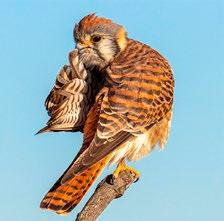


4. Replace button on blouse
5. Make coffee-flavoured bread.
D’oh, Ray Mears, Farce, Sew, Latte Dough. Seen on Twitter
Submitted via email
I went onto the Weight Watchers website earlier and it asked if I would accept cookies, which felt like a test.
I see that model villages will be reopening tomorrow, but you must maintain social distancing and remain at least six inches apart.
Comedian MOOSE ALLAIN
People said I’d never have the nerve to open my own soft drink canning factory, and they were right, because in the end I bottled it.
Comedian GARY DELANEY
I just discovered that potential future employers can look up your social media accounts. Which is exactly what I wanted to hear after a busy day working well as part of a team.
Seen on Twitter
I read a press release from Heinz saying: “We will never make a Bolognese version of our Alphabetti Spaghetti.
I thought, Blimey. They don’t mince their words.
Comedian OLAF FALAFEL
Twitter users share some of the most classic “dad jokes” from their fathers
@ThaKingSlayyer: “I asked my dad where my sunglasses were. He said, ‘I don’t know, where are my dad glasses?’”
@Wilk610: “My dad would order pizza by saying, ‘I’d like to order a 747… you know, a large plain.’”
@B_Lewis01: “My favourite dad joke is, ‘Knock knock’. ‘Who’s there?’ ‘Dishes.’ ‘Dishes who?’ ‘Dishes Sean Connery.’”
@KathyGoggin1: “Whenever we’d have lasagne for dinner as children, my step father Jim would always tell us to pull our plates closer so that we would get ‘less-on-ya’.”
CROSSWORD ANSWERS
Across: 1 Martian, 5 Descent, 10 Stun, 11 Unfriendly, 12 Songster, 13 Equine, 15 Santa Claus, 17 Rave, 19 Stir, 21 Impossible, 24 Amuses, 27 Smoulder, 28 Bottleneck, 29 Meet, 30 Wynette, 31 Precise
Down: 2 Astronaut, 3 Tonight, 4 Aquatic, 6 Exile, 7 Conquer, 8 Nylon, 9 Afar, 14 Ouzo, 16 Limb, 18 Valueless, 20 Rosette, 22 Shocker, 23 Islamic, 25 Moody, 26 Slept, 27 Shed

We chat to quick-witted QI “elf”, Andrew Hunter-Murray
WHAT WAS YOUR FAVOURITE PART OF WRITING A BOOK? Getting the questions in the first place, because they were so imaginative and weird and funny. People just have this huge range of things that they want to know about, like how you eat on the International Space Station, why clouds don’t freeze, or if—when you could be overwhelmed and underwhelmed—you could ever just be “whelmed”?
DO YOU HAVE A FUNNY TALE ABOUT WORKING ON QI? We often muck in and wear stupid costumes, pretty
much everyone has made it on air at some point now, including the office goldfish, who was called Alan—we made a little tank for him, which he could drive around by swimming into the corners. There’s a role for everyone.
WHAT’S YOUR FAVOURITE ONELINER? WC Fields, the legendary writer and drinker, from America in the 20th century said, “I always keep a drink handy in case I happen to see a snake, which I also keep handy.” That’s one of my favourites.
IF YOU WERE A FLY ON THE WALL, WHOSE WALL WOULD IT BE ON?
I’m thinking someone like PG Wodehouse, because I would get the jokes he was writing as he was coming up with them, although it might just be incredibly boring, right? It might just be sitting watching a man sitting at a typewriter, but that’s a risk I’m willing to take.
WHAT’S YOUR PET PEEVE?
Being abroad, asking for tea and then being brought some hot water and a tea bag separately. By which point, it’s far too late to combine the two and end up with anything that looks like a cup of tea. n
Funny You Should Ask: Your Questions
Answered by the QI Elves is published by Faber, £12.99 hardback

Think of a witty caption for this cartoon—the three best suggestions, along with the cartoonist’s original, will be posted on our website in mid-November.
If your entry gets the most votes, you’ll win £50.
Submit to captions@readersdigest.co.uk by November 7. We’ll announce the winner in our November issue.

Our cartoonist can breathe out a sigh of relief after a long stint in the loser’s corner, as he regained his crown this month with his hilarious caption, “Did anyone not stay up all night playing computer games?” Better luck next month, readers!

The iconic photographer looks back on a life behind the lens

READ ALL ABOUT IT?
We ask whether our constant access to news cycles is doing damage to our collective mental health
The Aussie funnyman on his new album, comedy and theatre
LAUGHCBD has taken the UK by storm and to date over six million adults have put it to the test, but with a myriad of different products and brands to choose from how do we know what we are buying?
Seed to Shelf Traceability is important as this guarantees the best quality CBD, as well as trustworthy products that comply with regulations. Reputable CBD brands like Goodbody can trace products from the field, all the way through the production and testing process, to the store. This seed to shelf traceability gives you complete confidence in each product that you buy.
Goodbody, based in Somerset, has an extensive range of CBD products formulated in the UK and tested at an independently managed, specialist laboratory to
ensure the products contain no THC , thus removing the illegal, psychoactive effects.
Make sure that you are buying a high level of CBD content –some brands sell products that offer a low % CBD content in large bottles.

D and CBD oil designed to give
With consistent 5* customers reviews why not give Goodbody CBD a try? Visit goodbodystore.com to browse the complete range and don’t miss out on the offer below.
With winter on the horizon, and immunity firmly front of mind, Goodbody has just launched a combined Vitamin D and CBD oil designed to give your immune system a boost in these uncertain times. C
Imagine a product that has the potential to naturally calm or boost your wellbeing.
Whilst stocks last! B




